CSIRO CEO Larry Marshall on the pathway to zero emissions

renewable energy: managing solar waste Cleaning up
QUEENSLAND TAKES
hydrogen to the next level
ISSUE 14 · June 2021 · www.energymagazine.com.au

Non-contact voltage and current measurements, through a clamp.
The Fluke 377 FC & 378 FC clamp meters. The newest members of the FieldSense™ family.
• Test faster and safer. Get simultaneous non-contact voltage and current measurements with Fluke FieldSense™ technology
• Power quality indicator to detect equipment or power line issues (378 FC Only)
• Complete 3-Phase voltage and current tests in 3 quick steps
Learn more:
fluke.co/377FC-378FC


Cover highlights our focus on wind energy in this issue, with features on the pathway to zero emissions, accelerating Australia's clean energy journey, and the ways in which we can give aging turbines a new lease of life.

For this issue, I’m writing my Editor’s Welcome off the back of two fairly large events for the energy industry – the launch of the Federal Budget for 2021-22, and the Smart Energy Conference and Exhibition.
Unsurprisingly, each of these events offered pretty different takes on where the future for the energy industry lies.
The Federal Government used the Budget to double down on its commitment to a gas-fired recovery from the COVID pandemic; while also earmarking $1.2 billion for emissions reduction.
And while that is a sizable contribution, many in the industry have described this year’s Budget as being full of “missed opportunities” when it comes to the inevitable transition to renewable energy.
Meanwhile, at the Smart Energy Conference and Exhibition – which kicked off the morning after the Budget was handed down – the focus has shifted away from policy somewhat, and towards the innovation that is happening within the industry, and that will drive the industry forward when federal energy policy will not.
In particular, Professor Martin Green – widely regarded as the “father of PV”
– discussed the way solar prices will evolve in the years to come, sharing his prediction that in the next few years we can expect to see power purchase agreements worth one cent per kilowatt hour.
With prices like that, it’s clear to see that this transition is happening, and will continue to happen at pace, with or without policy support.
Over the past couple of months a number of announcements from within the industry have served to remind us of this: the early closure of Yallourn; the release of Victoria’s game-changing Climate Change Strategy; a raft of hydrogen project announcements; and more big battery developments.
The other thing that gives me faith that the transition will continue to gather pace is you, the readers of Energy Magazine. It’s my job to understand the content that you engage with week in and week out, and consistently, that is stories about the evolution of this industry.
I can see how excited you are for change, and I know how passionate you are – let’s keep pushing forward to create the energy industry we all want to see.
Laura Harvey Editor
1
ISSUE 14—JUNE 2021 WELCOME EDITOR’S WELCOME Leading Energy Storage For when you need proven battery technology with guaranteed performance Evaluating your energy storage battery return on quicker payback on your capital outlay. Delivering fast, effective installation and commissioning. Once you’ve chosen the right system for your business, we’ll install We offer the latest energy storage battery technology coupled with a range of system-level guarantees, giving you absolute peace of Part of the Pacific Green Technologies Group Green Approach Technologies delivers industry can provide a full review commissioning service, Grid Scale / Co-Located Commercial & Industrial + www.energymagazine.com.au CSIRO CEO Larry Marshall on the pathway to zero emissions QUEENSLAND TAKES hydrogen to the next level renewable energy: managing solar waste Cleaning up Monkey Media Enterprises ABN: 36 426 734 954 C/- The Commons, Office 1, 36–38 Gipps St, Collingwood VIC 3066 P: (03) 9988 4950
(03)
Published by We’re keen to hear your thoughts and feedback on this issue of Energy. Get in touch at info@energymagazine.com.au or feel free to give us a call on (03) 9988 4950. June 2021 ISSUE 14 Editor Laura Harvey Associate Editors Imogen
Eliza Booth Contributing Editor Michelle Goldsmith Design Manager Alejandro Molano Designers Jacqueline Buckmaster Danielle Harris National Media and Events Executives Rima Munafo
Thompson Marketing Associate
Sud Marketing Assistant
Di Paola Publisher Chris Bland
F:
8456 6720 monkeymedia.com.au info@monkeymedia.com.au energymagazine.com.au info@energymagazine.com.au ISSN: 2209-0541
Hartmann
Brett
Radhika
Stephanie






2 FUTURE ENERGY 14 Taking hydrogen to the next level: Queensland’s Hydrogen Taskforce 18 Nuclear for net zero: facing the realities of a carbon constrained world 22 Committing to change: time for energy users to embrace clean energy 24 Australia’s clean energy journey: accelerating the transition FUTURE ENERGY 28 7 steps to maximise battery return on investment 30 Future Energy: pathways for Australia’s energy transition 32 Giving new life to aging wind turbines INDUSTRY INSIGHT 10 The pathway to a zero-emissions electricity sector by 2035 14 28 10 NEWS 4 AGL CEO quits “effective immediately” 4 EnergyAustralia gains new leader 6 SA-NSW Interconnector gains ElectraNet’s commitment 6 Hydrogen MOU signed for Gladstone 8 $160 million for Victorian Big Battery 8 Report: coal power plants unviable by 2025 EACH ISSUE 1 EDITOR'S WELCOME 64 FEATURES SCHEDULE 64 ADVERTISERS’ INDEX CONTENTS June 2021 ISSUE 14 www.energymagazine.com.au


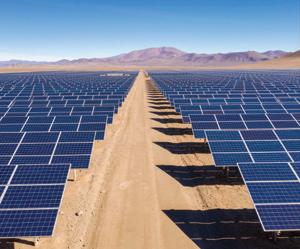

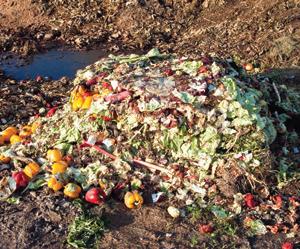







CONTENTS 3 ENERGY NETWORKS 34 State governments need to work together to plan renewable energy policies 38 This price is definitely not right 34 EVENTS 59 Making a difference in the energy transition ASSET MANAGEMENT 60 Lighting the way for a responsible and respectful energy transition 59 60 WASTE-TO-ENERGY 50 Turning leftover food and grease into power 50 SAFETY AND TRAINING 52 Polarity app makes for safer work practices 56 Unveiling the hidden risks in power system earthing 58 The safest way to measure voltage 52 STORAGE AND SOLAR 40 Waste not, want not: preparing for Australia’s solar waste problem 44 Rays the roof: accommodating home solar and batteries into the grid 48 Charging to export solar: will it send the system backwards? 40 www.energymagazine.com.au June 2021 ISSUE 14
AGL CEO QUITS “EFFECTIVE IMMEDIATELY”
AGL Managing Director and CEO, Brett Redman, has resigned after almost 15 years with the company, including the past two-and-a-half years as CEO.
The resignation came less than a month after Mr Redman announced AGL’s plans to separate into two business units – New AGL, focused on retail and renewables, and PrimeCo, the new home for AGL’s existing gas and coal generating assets.
The timing, and the fact that the decision became “effective immediately”, has led to much speculation of a difference of opinion between the AGL Board and Mr Redman regarding the best path forward for the soon-to-be split organisation – which Mr Redman was the architect of.
The official line has been that Mr Redman is simply moving on because he believed he could not make a long-term commitment beyond the proposed structural separation; and that the board agreed it was appropriate to put in place alternative leadership arrangements now to facilitate the separation.
AGL’s current Chairman, Graeme Hunt, has been appointed Interim Managing Director and CEO effective immediately, and will step down as Chairman. Mr Hunt will lead AGL throughout the process of planning for the structural separation, which is continuing, and includes consideration of the appropriate long-term leadership of the two proposed new businesses. Non-Executive Director, Peter Botten, has been appointed as Chairman, also effective immediately.
Mr Hunt said, “I wish to thank Brett on behalf of the board and all of AGL’s people for his service to the company.
“Over his time as CEO, Brett has returned the company to growth in its customer base and stabilised relationships with key stakeholders at a time of unprecedented uncertainty in energy policy and market conditions.
“In addition, the structural separation strategy Brett has sponsored gives AGL the opportunity to make material progress in our role in the energy transition.
“I look forward to working with the rest of the leadership team to deliver a successful outcome for AGL’s shareholders and all stakeholders as we drive this process to its completion.”
Mr Redman said, “After almost 15 years with AGL, I am proud of the contribution I have made to growing Australia’s largest multi-product energy retailer, assembling Australia’s largest electricity generator and founding Australia’s largest renewable investment fund.
“I am also pleased to have established the case for the structural separation of the business. The timing of my departure will enable the leadership team to be established to execute upon the separation strategy and lead the business into its next chapter.”
Mr Botten said, “I am honoured to be appointed Chairman of AGL. I want to add my thanks to Brett for his service to the company and to recognise Graeme for agreeing to take up the role of Interim CEO while we work through this important period.
“This will provide important continuity of leadership for the business and certainty for our people and shareholders while we work through the considerations of structural separation and establish a platform for future success.”
While Mr Redman’s resignation was effective immediately, he will remain available to the board of AGL until the end of his notice period, which concludes on 21 October.
ENERGYAUSTRALIA GAINS NEW LEADER
EnergyAustralia has appointed Mark Collette to be its new Managing Director, effective 1 July 2021, following current Managing Director Catherine Tanna’s decision to retire after seven years at the helm.
The leadership change was announced just a week after fellow big-three organisation AGL announced its CEO was moving on, but the announcements couldn’t have been more different.
In EnergyAustralia’s case, Chairman Graham Bradley AM and Ms Tanna couldn’t be more pleased with the new appointment.
“Succession planning began two years ago, and we’re thrilled that an internal candidate has been appointed following a comprehensive domestic and international recruitment process,” Mr Bradley said.
“Mark is a highly experienced executive who has played a pivotal role in positioning EnergyAustralia to navigate the complexities of the energy transition.
“Under Mark’s leadership we will continue to pursue opportunities as we build a modern energy business that helps keep the lights on.”
Mr Collette joined EnergyAustralia in 2003 and since then has led the Customer, Energy, Trading and Corporate Strategy
and Development teams. He is a director of the board of the Australian Energy Council, a former director of the Australian Financial Markets Association, member of the Reliability Panel and holds degrees in Aerospace Engineering, Business Administration and Economics.
Mr Collette succeeds Ms Tanna, one of Australia’s most respected leaders, credited as being one of the first in the industry to commit their business to become carbon neutral by 2050.
“I would like to take this opportunity to thank Catherine for her tremendous achievements and for developing a firstclass team,” Mr Bradley said.
“In her trademark authentic and approachable style, she built a culture that enables people to do their best work.
“Before COVID-19 changed the world of work, Cath had already encouraged progressive ways of working for EnergyAustralia’s people.
“She is also a passionate and genuine supporter of a range of social issues including diversity and inclusion, Aboriginal and Torres Strait Islander reconciliation and workplace giving.
“That an internal candidate succeeds her is testament to the investment she made in people.
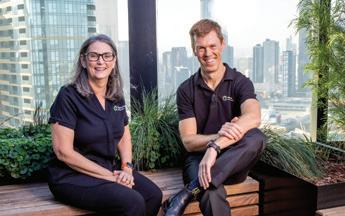
“She is widely respected by the people of EnergyAustralia and although she will be missed, we understand she feels that it’s the right time to pass the baton.”
Mr Collette said he is honoured to become EnergyAustralia’s next Managing Director and is particularly looking forward to bringing to fruition recently announced initiatives.
“I thank the board for this opportunity and am committed to carry on the work to build a thriving business capable of delivering momentous projects, such as Australia’s first four hour, 350MW utilityscale battery by 2026,” Mr Collette said.
Ms Tanna said that she is delighted that her successor has been appointed from within EnergyAustralia’s ranks.
“Developing leaders has been a priority and I’m so pleased that this has enabled us to deliver a leadership transition that best suits our business,” Ms Tanna said.
NEWS 4 June 2021 ISSUE 14 www.energymagazine.com.au

“Run with us – Your partner in Plastics”
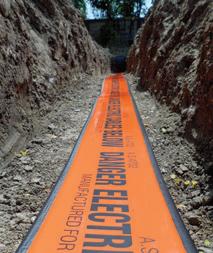
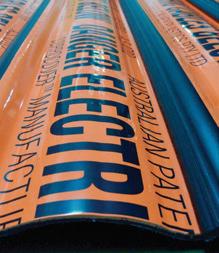




All Australian Supplied Electrical Cable Cover is manufactured in accordance with AS4702-2000 and is independently tested, by TUV Rheinland Australia
Unique rounded edging of the Cable Cover ensures maximum installer safety and reduces the risk of injury
100% Recycled Plastic
Notched Pallet allows web hoist to be safely fed through the coil and ensure safe offloading of larger coils
Gas Protection Covers available in a range of sizes
The Corrugated Cable Cover, is a patented product, manufactured under License
Thicknesses range from 3mm to 10mm, Widths available from 100mm up to 600mm
Standard Slab Length available in 1.2, and 2.1 Metre
Standard Coil Lengths are 10 Metre, 15 Metre, 20 Metre, 25 Metre and 150 Metre
Both Plastics Extrusions Thailand, and AGC Plastics, are 100% Australian owned and ISO accredited Companies
The product is continuously checked during the production cycle to ensure the surface finish, size, weight and impact strength are to the required specification
In-Line Printing allows for product batch and manufacture date for identification and tracing
Maintain strict control over all our procedures so as to maintain the highest quality of both product, and service to our customers

+61 432006775 rory@agcplastics.com.au
for further information.
Contact Rory Livingston AGC Plastics Pty Ltd 38 Sarton Road, Clayton Victoria, 3168 Australia www.agcplastics.com.au AGC Plastics has a number of quality distributors in Australia, as well as internationally. Please contact us
ELECTRICAL CABLE COVER
AS4702-2000
INTERCONNECTOR GAINS ELECTRANET’S COMMITMENT
The proposed SA-NSW Interconnector is a step closer to the final approval stage, with ElectraNet submitting its commitment to proceed with the project to the Australian Energy Regulator (AER).
ElectraNet Chief Executive, Steve Masters, said ElectraNet’s Board has resolved to commit to proceed with the South Australian section of the project, subject to the AER awarding incremental regulated revenue commensurate with the capital and operating costs of the project.
ElectraNet is continuing to work proactively with the AER to progress the project through its last regulatory approval, with a final determination anticipated in the coming weeks. Following the AER’s determination, ElectraNet would then enter its Final Investment Decision phase for the project.
When it released its preliminary position in December 2020 on the contingent project application for Project EnergyConnect, the AER indicated that the board resolution from ElectraNet as part of its application should fully reflect the contingent project trigger event.
“The board’s resolution fully satisfies the final contingent project trigger event requested by the AER to enable it to make a formal determination under the National Electricity Rules,” Mr Masters said.
“This is an important project for the national electricity grid and is a priority project for ElectraNet, the Australian Energy Market Operator (AEMO) and many other stakeholders.
“We look forward to concluding the regulatory approval process to support the timely delivery of the project in the interests of
electricity customers across the National Energy Market (NEM).”
In addition to the commitment to proceed with the project, ElectraNet has provided the AER with its latest review of the economic assessment of Project EnergyConnect considering recent announcements linked to the NEM.
“ElectraNet is mindful of the rapid pace of change across the NEM and the importance of the project delivering the expected benefits for customers,” Mr Masters said.
“We have modelled and considered the potential impact on the project’s benefits from recent policy and market developments –which were not included in AEMO’s 2020 Integrated System Plan – and have concluded that overall, the project benefits are likely to be higher than previously forecast.
“In fact, our latest economic assessment shows that, when combined, these recent market developments increase the expected benefits of the project by between $190 million and $440 million (present value) compared to the $1.9 billion previously reported in September 2020.”
Independent analysis shows Project EnergyConnect is expected to deliver net annual savings of around $100 for a typical household in South Australia and up to around $60 for a typical household in New South Wales – it will drive competition in the wholesale electricity market by connecting more, low-cost generation to the grid and support the ongoing transition to a lower carbon emissions future.
HYDROGEN MOU SIGNED FOR GLADSTONE
Ahistoric Memorandum of Understanding (MOU) has been signed with a Japanese multinational for a new hydrogen ecosystem in Gladstone.
Sumitomo Australia, Gladstone Ports Corporation (GPC), Gladstone Regional Council (GRC), Australian Gas Networks (AGN) as part of the Australian Gas Infrastructure Group (AGIG), and CQUniversity Australia (CQU) have joined forces to explore opportunities to develop a hydrogen ecosystem in Gladstone.
The ecosystem will initially pursue domestic offtake and mobility solutions before moving to enable large-scale export.
GPC Acting CEO, Craig Walker, said Australia’s National Hydrogen Strategy and Queensland’s Hydrogen Strategy set a vision for a clean, innovative, safe and competitive industry that benefits all Australians.
“Australia is uniquely positioned to be a world-class hydrogen energy generator and exporter,” Mr Walker said.
“With an exceptional port and the ability for the region to develop an abundance of clean energy, Gladstone is positioned to be Australia’s leading hydrogen export location by 2030.”
Gladstone Region Mayor Matt Burnett said he welcomes the development to the region, supporting the scale up from domestic generation and utilisation, to large-scale generation and export.
“From a community perspective this is great news for our region,” Mayor Burnett said.


“We are perfectly positioned to establish Australia’s first hydrogen ecosystem, and we have five parties that are fully committed to seeing this through to fruition. Gladstone has an excellent track record for development – the early opportunities in domestic gas offtake and mobility are very exciting.”
The MOU, signed at the Gladstone Entertainment Convention Centre, sets out a three-phased plan, commencing in 2021, with the key end goal by 2030 to see hydrogen exported from Gladstone to the world.
Yoshikazu Ishikawa, Managing Director of Sumitomo Australia, said the three-phased approach allowed tangible milestones, positioning Gladstone as an industry leader in hydrogen utilisation and technology.
“Sumitomo Australia is pleased to be working with an esteemed group of stakeholders who share our common vision of a Hydrogen Ecosystem in Gladstone.
“Uniquely positioned with a world-class port, exceptional solar radiance, skills, knowledge and technology, Gladstone is a strategic location with significant hydrogen potential to benefit both Australia and Japan.”
AGIG’s CEO, Ben Wilson, said, “We are proud to build on our existing partnership with the Queensland Government on Hydrogen Park Gladstone to bring us further closer to our vision to convert our gas networks and cities to renewable hydrogen.”
NEWS 6 June 2021 ISSUE 14 www.energymagazine.com.au
SA-NSW

OsmoFume
Wood Utility Pole Preservative System
Using OsmoFume to protect your wood poles from internal decay provides benefits to your utility infrastructure through added resiliency and extended asset life.



OsmoFume meets the rigorous performance and toxicity criteria established by the Australian Pesticides and Veterinary Medicines Authority (APVMA Reg. No. 88348/120987).
First dazomet-based wood pole fumigant commercially available in Australia. Dazomet provides superior long-term benefits when compared to a diffusible rod.
Proprietary, stick design provides a controlled dose and sufficient space for a copper accelerant, like Hollow Heart CB Wood Preservative (APVMA Reg. No. 90556/129272). ®
(08) 9300 2950 | enquiries@logsys.com.au | logsys.com.au/osmofume an company
$160 MILLION FOR VICTORIAN BIG BATTERY
The Federal Governmentowned Clean Energy Finance Corporation (CEFC) is providing $160 million for the construction of Neoen’s 300MW/450MWh Victorian Big Battery (VBB).
The VBB is set to help strengthen grid security, drive down power prices and support the integration of more renewable energy into the grid.
CEFC CEO, Ian Learmonth, said, “Energy storage supports cost-effective, reliable, clean electricity and is a key component of Australia’s transition to a low emissions economy.
“This project is a world-class example of how utility-scale batteries can help electricity networks support a higher penetration of renewable energy.
“The VBB will improve grid security by providing extra capacity during the peak summer months.
“It will also contribute to the dispatchable resources needed to underpin the increasing share of renewable energy that will make up Australia’s future energy mix.”
Under the System Integrity Protection Scheme (SIPS) contract Neoen has signed with AEMO, the VBB will unlock up to an additional 250MW of peak capacity on the existing Victoria to New South Wales
Interconnector. The extra power flowing between the states during the peak summer season will deliver support to the grid at critical times.
Independent analysis by PWC found that the SIPS process could deliver total benefits of more than $220 million to Victorian consumers in the next eleven years, including savings on power bills.
If gross savings and AEMO costs for the battery are passed on to consumers, the Portland aluminium smelter stands to save about $1 million a year on its electricity bills, while the average industrial Victorian electricity consumer could save about $280,000 a year.
Federal Minister for Energy and Emissions Reduction, Angus Taylor, said the project would give Victorians confidence in their state’s energy system.
“All Australians need access to reliable and affordable power, which is why the Morrison Government is focused on keeping the grid secure,” Mr Taylor said.
“After the challenges of COVID-19, this is more important now than ever to support jobs, families and businesses in Victoria.”
Lily D’Ambrosio MP, Victorian Minister for Energy, Environment and Climate Change, said, “The Victorian Big Battery is an important part of the largest modernisation of the grid in our state’s history.
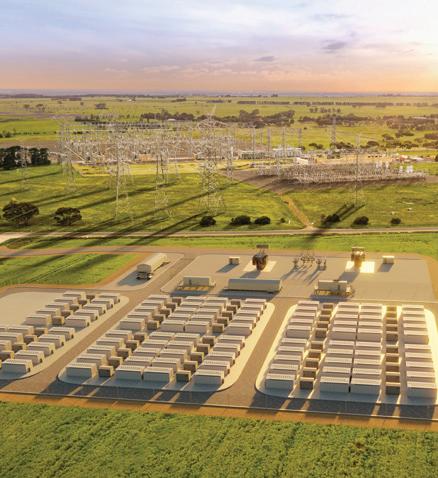
“It will create jobs and drive down energy prices, while supporting our transition to renewable energy.”
Xavier Barbaro, Neoen’s Chairman and Chief Executive Officer, said, “We are thrilled to be building our second big battery in Australia.
“The Victorian Big Battery once again demonstrates the value of innovative solutions that Neoen is proud to be pioneering.
“At 300MW, it will be one of the largest batteries in the world, taking our total capacity in operation or under construction in Australia to over 1.8GW, and bringing us one step closer to our global target of 5GW by the end of 2021.”
REPORT: COAL POWER PLANTS UNVIABLE BY 2025
The Institute for Energy Economics and Financial Analysis (IEEFA) and Green Energy Markets have released a new report which indicates that several coal power plants in the National Electricity Market (NEM) are likely to be financially unviable by 2025.
Several of the 16 coal power plants in the NEM will be financially unviable and at least one is likely to face closure several years sooner than planned due to coal plants’ poor flexibility and inability to adapt to a rapid influx of renewable energy, according to the report.
Tracking the announcements of proposed wind and solar projects, authors Tristan Edis and Johanna Bowyer found previous estimates of future power supply from renewables in the NEM to be understated.
A huge amount of renewable energy supply is expected to be added to the NEM. From 2018 to 2025, new wind and solar plants will add 70,000GWh of extra supply – which equates to New South Wales’ entire electricity consumption.
By 2025, it is forecast that the installed renewables capacity will include 8GW of utility-scale solar, 12GW of wind, and 22GW of rooftop solar*.
“The market is facing a tidal wave of new supply, much greater than anything government authorities or market analysts forecast or even contemplated just two years ago,” Mr Edis said.
“The supply added from 2018 to 2025 equates to over a third of the entire demand in the NEM, and more than eight times the annual generation of the Liddell coal-fired power station in NSW.”
Ms Bowyer said this extra supply will lead to a collapse in output from many of the existing fossil fuel generators.
“They will be displaced because wind and solar have no fuel cost and typically bid into the market with prices close to zero,” Ms Bowyer said.
“We predict that gas power station output will fall by 78 per cent and coal output by 28 per cent by 2025 compared to 2018 levels.
“The extra competition from wind and solar plants will also have a deflationary impact on wholesale electricity prices, as more expensive gas and coal generators will be needed far less.
“While prices will be more volatile, on average they are likely to return back to the kinds of levels that prevailed in 2015.
“This is because the extra supply from renewables is several times greater than that lost from the closure of Hazelwood, Northern and Liddell Power Stations.”
*This forecast excludes any additional supply expected from the NSW Government’s Infrastructure Roadmap.
NEWS 8 June 2021 ISSUE 14 www.energymagazine.com.au
THE NEXT STEP IN BATTERY TECHNOLOGY
Zenaji AEON, Lithium Titanate Batteries allow you take full advantage of your home solar installation, delivering the best lifespan and performance on the battery market.

Available from R&J Batteries and distributors across Australia. Talk to the experts on how Solar Storage can work for you.
// 1300 769 282 // rjbatt.com.au/store-locator
YEAR W ARRANTY
20
THE PATHWAY TO A ZERO-EMISSIONS
ELECTRICITY SECTOR BY 2035

 by Dr Larry Marshall, Chief Executive, CSIRO
by Dr Larry Marshall, Chief Executive, CSIRO
For years now, the industry has been puzzling over the path towards zero emissions. Here, CSIRO Chief Executive Larry Marshall weighs in, outlining the research his organisation has conducted into how the industry needs to transform.
June 2021 ISSUE 14 www.energymagazine.com.au 10 INDUSTRY INSIGHT

www.energymagazine.com.au June 2021 ISSUE 14 11 INDUSTRY INSIGHT
My son recently completed a school project on solar energy. I was astounded at his literature review.
At the one end were articles claiming coal would always be cheaper than renewables and renewables would never deliver stable, reliable energy. At the other were articles claiming renewables have been the cheapest source of energy for a decade and are stable because the wind blows when the sun doesn’t shine.
Unfortunately, neither are entirely true. You’d be forgiven for not knowing who or what to believe.
CSIRO recently released our GenCost report for 2020-21, which we produce each year with the Australian Energy Market Operator to assess electricity generation and storage costs.
We work with a range of real-world industry players to provide a data driven, scientifically researched model that projects the cost to generate electricity for new power plants in Australia, including coal, gas, wind and solar.
We also project future changes in costs based on our CSIRO technology roadmaps, and the progression and impact of technology advancement in areas like storage.
I want to share some of our findings here to help separate myth from fact.
But first, some context.
CSIRO has analysed and projected energy futures for more than two decades, and we are working with the Australian Government and industry to catalyse the transformation of our energy sector.
It’s one of the biggest industry shifts we’re likely to see in our lifetimes, and we want to get it right.
Over those two decades, we have forecast and tracked the reduction in cost of key types of utility-scale power generation, including renewables, and more recently the development of battery storage options (including our own UltraBattery which has been helping stabilise the United States power grid in Eastern Pennsylvania).
For much of this time, a system called LCOE (Levelised Cost of Electricity) has been the methodology for a consistent comparison between technologies and costs.
While a useful starting point, due to its relative simplicity, it fails to account for the associated ‘system’ costs of different technologies, and in particular, non-dispatchable renewables such as wind and solar. This is a critical factor to be addressed as our grid transforms itself.
Many studies have claimed cost parity for renewables with coal and gas over the last decade, but have typically excluded the costs associated with grid stability and security – a big issue in Australia where we have vast distances and sparse populations.
With the stage now set, let’s talk about our GenCost report, which is in its third year of publication.
Large-scale solar and wind becoming cost competitive with gas
This year we focused on improved representation of system integration costs – moving beyond LCOE to consider how the mix of energy technologies integrate, plus the need for (and cost of) balancing technologies like storage.
While we have tried to incorporate system costs in a very simple form in the past, this time we explored more effective ways to estimate and account for system impacts.
For the first time, we started to see large-scale solar PV and wind becoming cost competitive with gas on a ‘system’ basis.
Our previous GenCost report found that renewables were and continue to be the lowest cost new-build technology, but when we added the cost of storage, some gas generation was available at comparable cost.
But in this report, we clearly see that by 2030, if large-scale solar and wind are deployed at up to 60 per cent share – even with storage and grid integration costs – they will be significantly more competitive than gas across all plausible future gas prices.
While this is excellent news, this does not mean we should abandon gas – quite the contrary.
Keeping gas in the mix will allow for a faster transition
Existing gas plants are cheaper than new builds and are well placed to provide the flexibility and dispatchability we need as we add more variable renewables to the grid.
CSIRO’s Australian National Outlook, which projected what Australia could look like out to 2060, mapped scenarios to limit global warming to 1.5 degrees Celsius.
Generally, that goal requires a zero-emissions electricity sector by 2035, because other sectors are harder to reduce. To reach that, we will need around 75GW of variable renewables in the energy system, which is about 5GW of new variable renewables generation capacity installed each year.
Australia has already demonstrated it can deploy 5GW of variable renewables per year, and almost every state has tens of gigawatts of projects in the planning phase.

June 2021 ISSUE 14 www.energymagazine.com.au 12 INDUSTRY INSIGHT
That puts Australia in a great position to reach our goal and contribute to global emissions reduction.
Keeping gas in the mix will allow for a faster transition, because it is around 30-50 per cent lower in greenhouse gas emissions than coal, and offers a pathway to gradually introduce hydrogen to further reduce emissions.
Coal still the cheapest existing electricity source for the time being
Looking across the spectrum at some of the other findings from GenCost, today existing brown coal is still the cheapest electricity source, followed by existing black coal and existing gas.
While this is broadly true, there are different markets at play here. Gas rules the evening peak period, and solar is substantially impacting the market share of coal in the daytime.
But we will soon see this start to shift as around 80 per cent of gas and coal assets reach their end of life and are retired over the next 20 years. This will happen quite naturally, driven by market forces, and does not require government intervention.
Over the same period, the cost of storage will continue to come down, and it will become more attractive to build variable renewables either integrated with their own storage or installed elsewhere in the grid.
And they won’t need some form of carbon pricing to help them.
GenCost shows that renewables plus integration costs are already lower than all other options for new generation, with or without a carbon price.
But to be realistic, it will take at least a decade, if not more, for wind and solar generation capacity to grow to reliably produce enough power to reach what coal does today.
In the meantime, we will need gas to cover the gap, and buy us time to build the renewable generation capacity and storage we need.
We can’t go renewable without storage
By 2030 we expect Australia will be at around 50 per cent renewables, with some states such as South Australia exceeding that by a significant margin.
This means energy storage will be critical, because we can’t go 100 per cent renewables without storage.
We’ll need different solutions depending on the situation and geography.
In general, batteries work well for short durations (hours not days) and lower loads, while pumped hydro is designed for much longer periods. Snowy 2.0, for example, has the capacity to
provide 175 hours or more than seven days of stored power – a true workhorse.
Each has their pros and cons, but we’ll need both to power Australia’s transition to renewables. Fortunately, we’ll have time to build them.
By 2030 we expect grid integration costs to be low enough that renewables will be clearly the lowest cost option, and we will power on to 100 per cent renewables over the next two decades.
Hydrogen is another storage option we are developing that combines the best of batteries and pumped hydro. The beauty of this option is that it can be made and consumed here, and exported in bulk to help our neighbours.
Fuel for industry and growth
But electricity production is only one third of our energy demand – the lion’s share is used by industry.
Despite our passion for solar and wind, we still need fuels for industry, for heating and transport. Australia must have low-cost energy to give our industries a globally competitive edge.
Solar and wind can simply not deliver power fast enough (literally high current over a short time) to support our industrial processes.
If you’ve ever tried to boil your billy with your car battery while camping, you’ll know that it takes a good 30 minutes and flattens your battery while fuel (LPG) does it in minutes.
We need solar and wind, but we also need a low to zero emissions fuel for industry. That fuel will be gas in the short term, and hydrogen over the longer term as we transition.
Australia has some unique challenges – our geography and population size means we have the world’s longest and least interconnected electricity grid.
But we also have the world’s largest penetration of residential solar, which is consumer-led and continues to grow. And we have a world-class science sector innovating in low-emissions technology.
Australian science invented the low-cost solar cell design that is used around the world today.
We invented futurefeed, which almost eliminates emissions from cattle – the world’s third largest emitter if they were a country.
And we invented the hydrogen cracker to enable a liquid renewable fuel for transport and industry.
We have the power to make sustainability profitable. To reduce the emissions – but not the profits – from our industries.
It’s not a matter of policy or politics, it’s simply a matter of performance.
Science can deliver that profitability, and industry will leap. That’s how we will change the world.
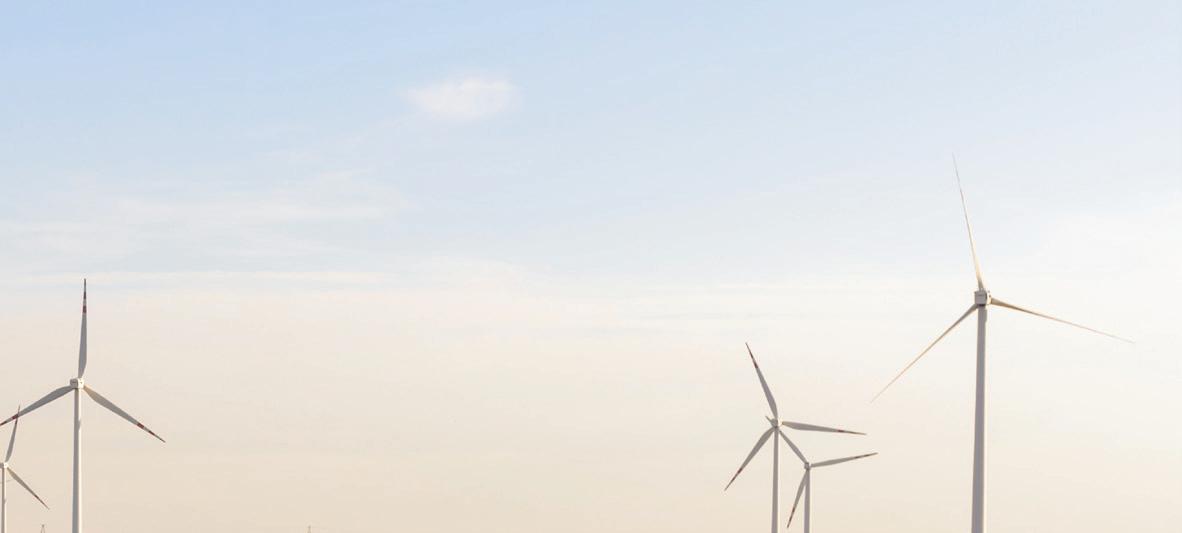
www.energymagazine.com.au June 2021 ISSUE 14 13 INDUSTRY INSIGHT
TAKING HYDROGEN TO THE NEXT LEVEL: QUEENSLAND’S HYDROGEN TASKFORCE
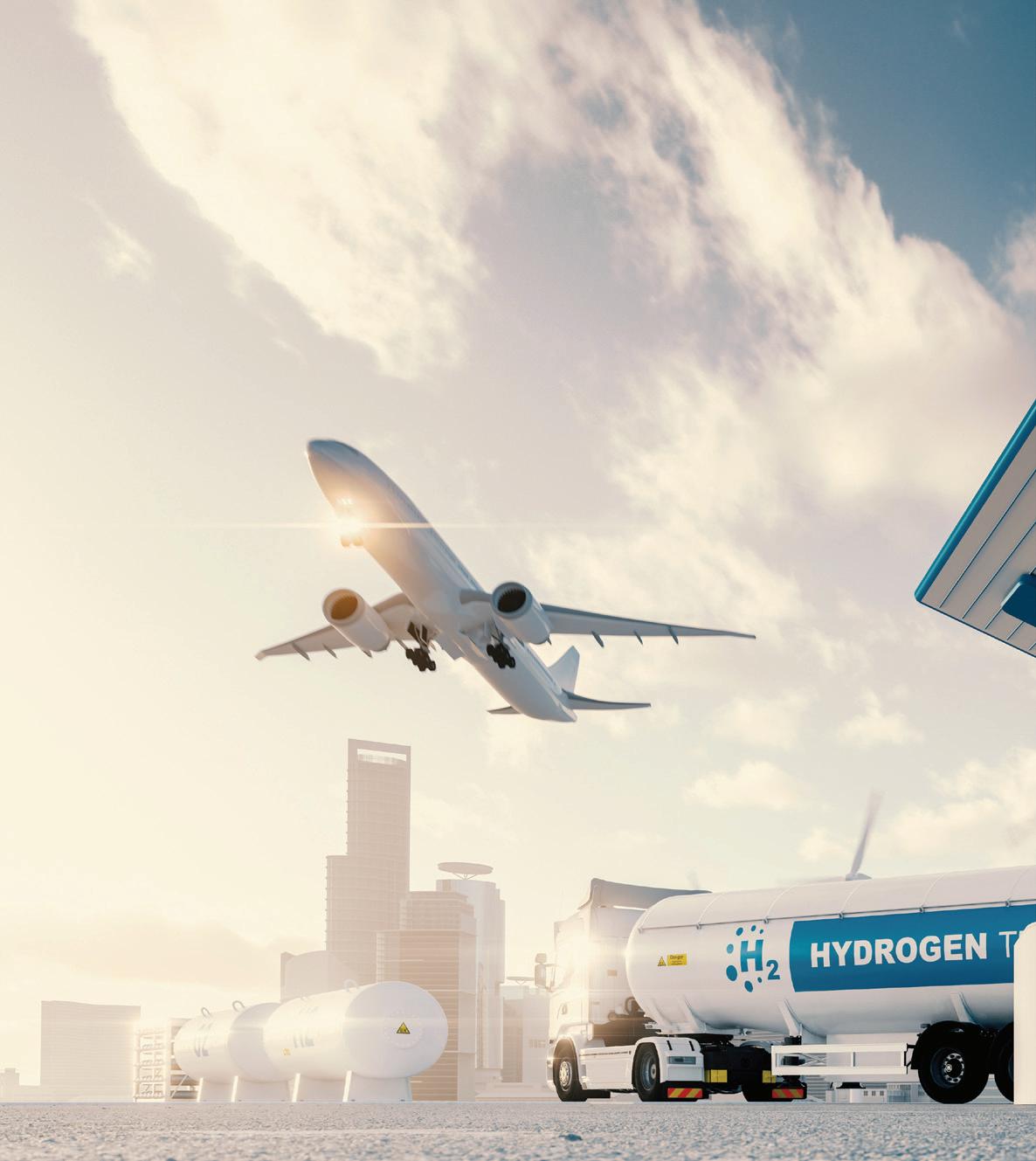
June 2021 ISSUE 14 www.energymagazine.com.au 14 FUTURE ENERGY
by Eliza Booth, Associate Editor, Energy Magazine

www.energymagazine.com.au June 2021 ISSUE 14 15 FUTURE ENERGY
Hydrogen is the hottest topic in the energy industry right now, and no one is more bullish on this new technology than the Queensland Government, which has just announced the establishment of a specialised Hydrogen Taskforce, tasked with fasttracking the establishment of a sustainable hydrogen supply chain for the state. Energy magazine spoke to Mick de Brenni, Queensland Minister for Energy, Renewables and Hydrogen; and Chair of the Hydrogen Taskforce, Professor Peta Ashworth, about how the Taskforce is helping to establish Queensland as a leader in hydrogen and renewable energy generation.
The seven-person Hydrogen Taskforce – announced on 11 March 2021 – brings together industry, academic and public sector leaders to create Australia’s first dedicated hydrogen development team, led by Professor Peta Ashworth, Director of the Andrew N. Liveris Academy for Innovation and Leadership, and Chair in Sustainable Energy Futures at The University of Queensland. Mr de Brenni told Energy that the Taskforce is currently underway with its first objective – delivering a work plan that will map out Queensland’s hydrogen journey.
“The Hydrogen Taskforce symbolises our genuine commitment to establishing a renewable hydrogen supply chain out of Australia, led by Queensland,” Mr de Brenni said.
“We have some of Australia’s leading public servants as part of the Taskforce. Their first deliverable is going to be setting out a work plan for how Queensland can meet the opportunities that are set out before us, and also to meet our responsibilities internationally.
“We know that we are incredibly well-placed in terms of our abundance of renewable energy. We want to leverage the growth in renewable energy that we’ve seen in Queensland with around $8.5 billion in investment already, and a further 60GW of projects on the books as part of our renewable energy zones.
“The Taskforce really will ensure that the livelihoods of Queenslanders and their lifestyle is front and center in the thinking when it comes to the policy directions that our government establishes to meet that opportunity, and to respond to that global responsibility.”
Mr de Brenni, who made history as Australia’s first minister for hydrogen, said he wanted to ensure that the work plan for the Taskforce is focused on ensuring the state can deliver on the nation’s hydrogen potential with Queensland at the helm.
“I think it's reasonable to assume that this work plan will be iterative. It will need to be agile and we want to be able to respond to new opportunities as they arise. But we've got a pretty good handle on some of the key things that will need to be incorporated into that.”
The perfect place for hydrogen
There’s no doubt that Queensland is a prime position for renewable energy generation with its abundance of sun, wind, water and significant investment in renewables, as well as its publicly-owned asset base, which will be integral to producing and exporting hydrogen.
Mr de Brenni said that there has already been significant investment in Queensland’s renewable energy zones, including the
announcement of the State Government’s $500 million Renewable Energy Fund in 2020.
“I think it's important that we note and recognise that Queensland is very well-placed to apply strategic policy settings in the energy sector, because Queenslanders own their energy system. They own the generation, the transmission, the distribution, and when it comes to exporting commodities like renewable hydrogen around the world, Queensland has owned their ports as well,” Mr de Brenni said.
“Match that with the abundance of sunshine and access to water, there is probably nowhere else in the world where the opportunities to deliver renewable hydrogen commercially at scale are as good as they are here in Queensland.
“Not only will that benefit the emissions reductions objectives of other nations, it'll also help us continue to drive down electricity costs here in Queensland. We've seen the last three years an almost eleven per cent decline in prices. The forecast for the three years ahead is for a further 14 per cent decline in prices. What that means is that if we can deliver continued downward pressure on prices through renewable energy supported by a hydrogen manufacturing sector, that we think that we can significantly grow Queensland-based manufacturing, particularly in our regions, and support the sustainability of our resources sector. So this is very key to the economic development of Queensland.”
Professor Ashworth said that while hydrogen is not new, clean hydrogen presents an amazing opportunity for countries across the world to decarbonise and assist them in reaching their emissions reduction targets. With the cost of generating renewable energy coming down, allowing the sector to build at scale, the future of hydrogen is looking brighter than ever, however Professor Ashworth said that lining up a supply chain is key to ensuring the success of hydrogen production and exporting.
The role of the Hydrogen Taskforce
For Professor Ashworth, the role of Chair of the Hydrogen Taskforce was slightly daunting at first, but she also saw it as a real opportunity for change and growth for the state and hydrogen production.
“My passion is around, ‘how do we overcome the challenges of climate change mitigation in a way that is fair for all society’. I've been working in that research for a long, long time, so I thought this was actually a really nice addendum to that.”
Professor Ashworth said that the first milestone for the Taskforce will be to get the work plan completed, however that would only be the beginning of the coordination of resources that would need

June 2021 ISSUE 14 www.energymagazine.com.au 16 FUTURE ENERGY
to be done. Professor Ashworth said that ongoing coordination across community, industry and government is key to successfully establishing a hydrogen supply chain in the state.
Among that coordination is collaborating with the broader Queensland community, industry and governments to look at what opportunities are on the table right now, where future opportunities lie, the different regulatory approvals or changes that may need to be made, and the precincts that will be able to best facilitate hydrogen projects in the future.
“[Professor Ashworth] has been talking to me about one of the critical roles of the Taskforce, which is supporting collaboration. If we can get that regulatory environment right, and see further collaboration, I think that's going to be key to meeting our nation's objectives,” Mr de Brenni said.
“A lot of commentators have asked me about, well, who should be first? Should it be Queensland or Victoria or South Australia, or Tasmania? Well, I think ultimately this is an opportunity for our nation. Queensland just thinks that we have a lot to offer and can make a significant contribution to that. So I think there are a few policy spaces across government, or across our national landscape, where the level of collaboration is as strong as it is in the development of a hydrogen supply chain.
“Whether it's government corporations or academia, everybody's in lockstep in terms of the end goal. The job for the government and the job for the Taskforce is making sure that we can get there in a way that supports outcomes for Queensland, primarily, but for Australians generally.
“I fundamentally think there's enough demand for renewable hydrogen across the world that there are going to be places in Australia, including Queensland and other states, that will be able to partake in the development of the supply chain and may contribute to export. However, our intent is to ensure that the supply chain is led out of Queensland.”
Mr de Brenni said that fundamental to establishing the Taskforce was ensuring that the work undertaken in the hydrogen space was done in an optimal fashion to deliver the best outcomes for everyone. This is why the Hydrogen Taskforce is so important – to ensure that the proper planning, upskilling, education and supply chains have been established so they can be deployed when the time comes.
“There is a significant amount of effort and investment being applied by universities, by local governments, by federal governments, by other state governments, by commercial partners and our trading partners. But the responsibility of the State Government is to ensure that we have an environment in which that effort can be applied in a way that delivers the best outcomes,” Mr de Brenni said.
“By way of example, we know that one of the challenges we need to overcome is having a workforce that is ready to deliver this for us. So we've invested in two hydrogen training centres; one for gas fitters, one for electricians. Construction of one is underway. The final design work for the other is nearing completion.
We will invest in the training and development of our young Queenslanders. So we're investing in a TAFE and a high school in Townsville and Gladstone respectively.
“It's being able to pull those levers and ensure that that piece is being worked on, so that when the call comes that we need thousands of Queenslanders ready with their tools to build this infrastructure, they will have the skills that they need. We will have done the precinct planning to ensure that they go to the right place. We’ll have prepared the port so that it's ready to take the ships. We’ll have prepared the transport infrastructure. We’ll have deployed this resource into our fleets and our domestic pipelines into residences, so that Queenslanders get the benefit of that already.
“It's really about ensuring that the planning leads to the optimal outcome, that we've got the workforce ready to go, and that the Taskforce drives an environment of collaboration. “
The future of hydrogen
Looking to the next twelve months, Mr de Brenni said there are several milestones the Taskforce would like to reach to advance the state’s hydrogen generation.
“Here in Queensland, especially, we would like to be implementing our work plan. In the short term, we expect to see some initiatives that are well-developed and in market, including gas blending into domestic residential pipelines,” Mr de Brenni said.
“We expect to see some fleet on the roads, and potentially on water. We expect to see a resolution of trade competencies and workforce training getting underway."
Professor Ashworth also agreed, saying that implementing the Taskforce's work plan is top priority for the short to medium term. In addition, Professor Ashworth highlighted the need to connect with communities and regions to identify where opportunities lie for different components, as well as initiating and facilitating crucial skills training that will be essential to the future of hydrogen generation in Queensland.
“I think giving comfort to communities that this is a long-term goal, and where they will fit within that to give them clarity about their future. Obviously as we transition, there'll be different communities affected in different ways so if we can provide that security, I think that's a good start.”
As for those within energy utilities who may be looking at how they can incorporate hydrogen into their existing business models and take advantage of the opportunities hydrogen presents, Professor Ashworth said that collaboration is key to successful integration.
“If there's questions that are emerging, I'd say reach out to the Taskforce because this is a two-way street as we move forward.
“This is where collaboration is key as well as public and private partnerships, working with government, working with industry and also the research components. That's what I think we're seeing hydrogen bring together.”

www.energymagazine.com.au June 2021 ISSUE 14 17 FUTURE ENERGY
NUCLEAR FOR NET ZERO: FACING THE REALITIES OF A CARBON CONSTRAINED WO RLD
by Benjamin Heard and Jonathan Armstrong, Frazer Nash Consultancy
While countries around the world are laying down their targets for achieving net zero emissions, Australia is still yet to commit to a net zero timeline. But pressure is mounting, and according to Benjamin Heard and Jonathan Armstrong, we need to face the reality that nuclear energy should be part of the transition to net zero in Australia.
The expression net zero has swiftly become a global rallying cry that has taken a firm hold at the highest levels of policy.
It is an elegant, scientifically-robust concept, focused on an outcome – emit no more greenhouse gas than we can remove. Given global emissions of carbon dioxide alone from combustion of coal, oil and gas are around 33 billion metric tonnes per year, the emphasis must be on the “zero”. We cannot plausibly remove or store emissions on that scale – we must in fact halt emissions on that scale. This requires technologies, processes and systems of social organisation with zero climate impact that enable people to continue to live in health, safety, security and reasonable prosperity. There is no cap under which we can trade, no bureaucratic attempt to ration the global atmospheric commons. There is a single goal, relevant to all, that can be reached through the development and scaling of solutions which mean cleaner air and advantageous re-industrialisation.
No wonder net zero is proving itself to be politically durable. However, challenges lie ahead. Popular focus remains on our power grids, which are only responsible for about a third of Australia’s national emissions. Transport, along with industrial processes and direct combustion, are responsible for more than 53 per cent of emissions. Agriculture, waste and fugitive emissions account for 13 per cent. We have limited examples of near-zero carbon power grids worldwide, and no economy-wide examples merging zero-carbon power, transportation and industry. It is a race into the broadly unknown.
Understandably, Prime Minister Scott Morrison emphasises a need for confidence in how net zero can be achieved and with what technologies. Whilst well-endowed with raw renewable energy potential, Australia is immensely dependent on consumption, import and export of fossil fuels. We also maintain legislative prohibitions against the use of nuclear technologies.
June 2021 ISSUE 14 www.energymagazine.com.au 18 FUTURE ENERGY
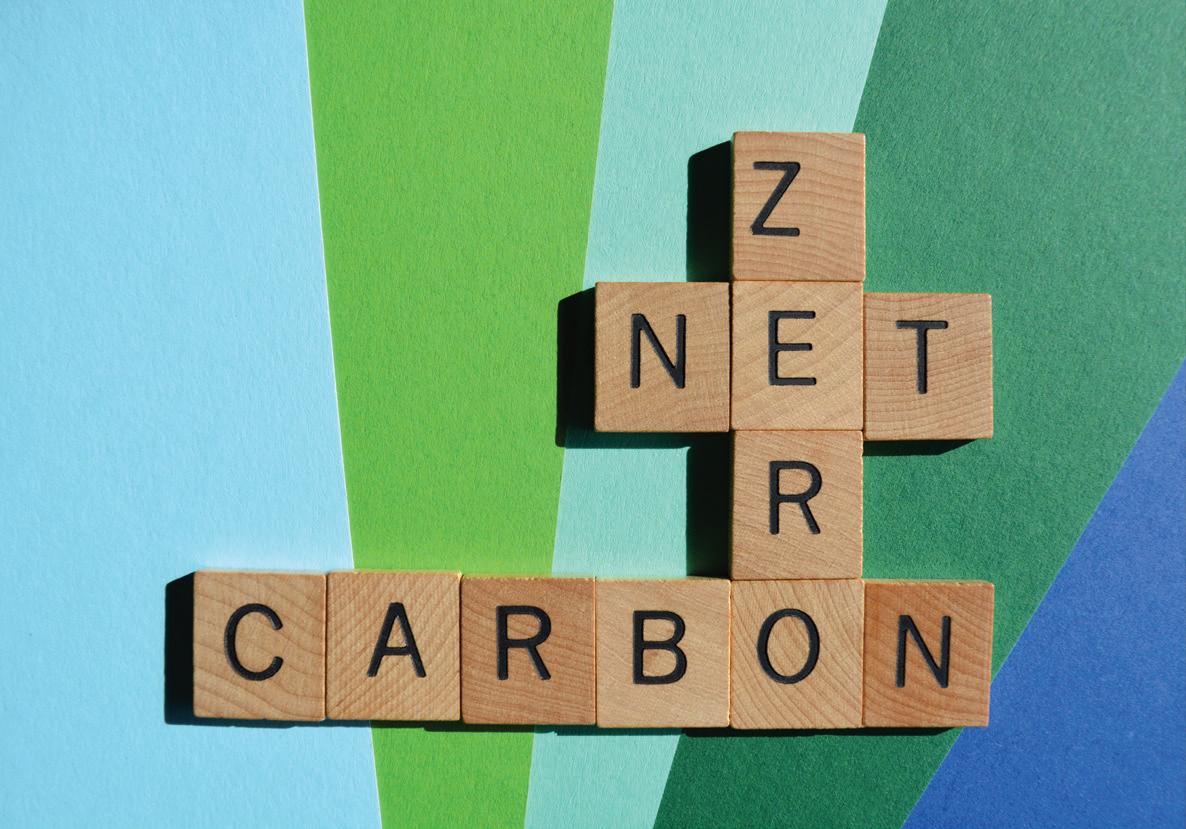
Our major trading partners, who are lining up behind net zero, have nuclear technologies in the frame. The United Kingdom, United States and Canada are all making accelerated efforts for a new generation of indigenous small modular reactors. China’s recently announced expansion plans, to a 300GW sector, has left analysts in no doubt of their intentions. These technologies offer clear technical advantages in reliability, firm capacity and scalability that set them apart from weather-dependent power generation. Crucially, they are also direct providers of net zero heat. This is essential for powering industrial processes, including a new hydrogen economy.
The potential role of hydrogen is becoming more broadly understood, as a direct fuel, a vital ingredient to industry, and a path to synthetic transport fuels. But the scale required remains unappreciated. Consider Australia’s imports of fossil oil – approximately 2,400PJ per year. If Australia’s entire current wind and solar capacity was redirected to committed hydrogen production, we might make in the order of three per cent of the energy in our oil imports as hydrogen. If we use only that which is presently curtailed supply (the excess that occurs when wind and solar is in relative plenty), our hydrogen production potential falls to a small fraction of one per cent of current oil imports.
This is confronting. Net zero is arguably unachievable in Australia through continuing incremental growth in variable renewable supply, and creative sponges for the excess. We must build our thinking backwards from the outcome. Net zero means creating
and sustaining an interlinked system of energy creation, industrial production and energy supply that will dwarf the existing electrical supply capacity, with massive-scale production of zero-carbon electricity and heat at its heart.
From that back casting view, the role for advanced, hightemperature small modular reactors (SMR) becomes clear. A fit-for-purpose size that can connect to the existing grid, SMRs offer full-time production of electricity and heat. This supports hightemperature steam electrolysis – a more efficient and productive path to hydrogen production. Positioned as multi-purpose devices, SMRs will support the further cost-effective integration of variable renewables, while maximising production of hydrogen and synthetic fuels, and ensuring best, economical use is made of all storage capacity in the grid. Their synchronous generation, which can run day long in a net zero industrial system, will maintain the essential system grid security currently under threat from the departure of Australia’s coal sector. Viewed from the essential systems perspective, SMRs are a benefit multiplier on the road to net zero.
However, those benefits are inaccessible to Australia under current policy settings. Policies can, ultimately, be changed quickly. But the acquisition and deployment of new technologies, while possible to accelerate, cannot be rushed.
Australia’s approach to offshore renewable energy is a case in point. While not prohibited, we have no extant sector, and we cannot have one that is producing power tomorrow, or even
www.energymagazine.com.au June 2021 ISSUE 14 19 FUTURE ENERGY

next year. Australia is developing the legislative and regulatory settings that will enable benefits from those technologies in years and decades to come, while ensuring smooth integration with social and environmental needs and expectations. A like-minded attitude is required for SMRs.
Technologies can only flourish in the context of capabilities. In capabilities, Australia has a reasonable foundation for future use of SMRs, but serious work ahead. Global developments in SMRs are swiftly overtaking the Australian status of “watching brief” expressed in the 2019 Energy White Paper. A pivot is required, from “watching brief” to roadmaps and action plans, if we are to have a timely inclusion of these solutions to take us to net zero.
Australia’s trading partners and competitors are quickly setting the industrial ground rules for the rest of this century – net zero, technology-inclusive industrialisation with a clear role for nuclear technologies.
It is beyond Australia’s reach to alter this, but it is well within our reach to benefit from it. That needs a systems thinking approach, working backward from a future state, to prepare and deliver full-scale re-industrialisation. The conversations that link policy with engineering need to happen early. It is a race to the top, and like any race, you need to be in it to win it.
About the authors
Based in Adelaide, Jonathan Armstrong is Director of International Business, serving on the Board of Frazer-Nash. He started his career in the UK’s civil nuclear industry, where his roles included leading a major project to increase the enrichment of the UK’s nuclear fuel, leading teams providing specialist technical support for in-reactor fuel behaviour and authoring safety cases requiring the highest level of experience. He has also run a clean energy start up in the UK and founded Frazer-Nash’s operations in Scotland. In 2015 he relocated with his family to Australia to lead Frazer-Nash’s international business. Jonathan studied physics at Edinburgh University and is a Companion and Engineering Executive with Engineers Australia.


Ben Heard is a Consultant with Frazer-Nash, and also the Founder of the environmental NGO Bright New World. Australian-born and raised, he holds a Masters in Sustainability and a professional background in climate change related work. Formerly anti-nuclear, Ben is wellknown for his evidence-based reappraisal of nuclear technologies considering the need to address climate change. He has since become a globally recognised advocate for the use of nuclear to address our biggest challenges, including presentations at COP21 in Paris (2015) and organised protests at COP23 in Bonn (2017). He completed PhD studies in 2017 including the highly-cited paper Burden of Proof, and joined Frazer-Nash in 2018. He has featured in 60 Minutes, and the international documentary film Juice: How Electricity Explains the World.

June 2021 ISSUE 14 www.energymagazine.com.au 20 FUTURE ENERGY
A small modular reactor.
Looking for a complete solution for online events?

Combining our experience in publishing, live events, digital marketing and video production, Monkey Media has the capability to deliver a range of online events for your organisation.



Specialising in the energy, infrastructure and utility sectors, we combine our expert knowledge in these fields with our behind-the-scenes knowhow to help you deliver your events in a range of online formats.
We work closely with our partners to understand why and how you want to connect with your audience online, and can recommend the right solution to help you cut through and achieve the high levels of audience engagement and participation you’re looking for.
Some of the online events we can help you deliver include:
Webinars
Virtual conferences
Awards nights
Round tables
Online learning
Hybrid virtual/live events for a complete online event solution
9988 4950
03
www.monkeymedia.com.au/services/custom-virtual-events/
COMMITTING TO CHANGE:
TIME FOR ENERGY USERS TO EMBRACE CLEAN ENERGY

The global pandemic provided many of us with the chance to pause and reassess traditional ways of doing things. As we emerge from the crisis, it’s time for energy users large and small to firmly commit to the benefits clean and alternative forms of energy can provide.
Although greenhouse gas emissions improved in 2020 due to travel bans and economic slowdowns resulting from the COVID-19 pandemic, the United Nations highlights that climate change continues to affect every country on every continent.
The UN Secretary-General has proposed a raft of climate-positive actions for governments to take in the process of rebuilding their economies and societies in the years ahead, aimed at triggering long-term systemic shifts to change the trajectory of CO2 levels in the atmosphere.
While the UN’s goal remains to reduce global emissions by 50 per cent by 2030, the Australian Government has committed to a net zero goal “as soon as possible”, and preferably by 2050.
The transition will require bold, forward-thinking policies at both a state and federal level, backed by targeted government spending.
Henry Anning, Chief Executive Officer of ResourceCo Energy Systems, said the recent announcement of funding support for recycling and clean energy manufacturing projects under the Modern Manufacturing Initiative (MMI) is encouraging.
Acknowledging the pace of change required in the energy sector in Australia, Mr Anning said the release of a defined roadmap for the advancement of the industry is a significant step forward.
“It really marks the beginning of a collaborative, long-term clean energy strategy framework, bringing industry experts across the sector together to drive a positive transition.
“Assisting Australian manufacturers be more competitive, resilient and build scale in the global market will be critical to achieving sustainable outcomes.”
The Federal Government’s Recycling and Clean Energy National Manufacturing Priority roadmap, released in April 2021, highlights that investor and market appetite for clean energy in Australia and around the world is undeniable, but Australia is yet to convert this into large-scale manufacturing opportunities.
The domestic supply chain for clean energy components remains underdeveloped and adoption of clean energy for
industrial manufacturing is still in its early stage as a proposition, especially in heavy manufacturing processes.
Mr Anning agrees demand for alternative energy solutions is a common barrier, however, he believes the industry is at the cusp of making real progress – a position supported by the announcement of the closure of the Yallourn Power Station four years earlier than planned.
“As more of our very old, expensive and polluting coal-fired power stations begin to close, the demand for cleaner, greener solutions will very quickly ramp up.
“It is encouraging that governments and industry are working together to intensify efforts to position Australia as a global hub for renewable energy.
“We need continued collaboration between governments, investors, manufacturers and their customers to enable, shape and create markets for renewable energy – green products.”
As a company, ResourceCo is a leader in the development of waste-from-energy plants, which deliver strong environmental and economic outcomes by repurposing materials otherwise destined for landfill, to generate clean energy.
ResourceCo Energy manufactures processed engineered fuel primarily from waste timber materials, but also previously nonrecyclable plastics, cardboard, paper and textiles.
“It’s time for large-scale business to see alternative energy as a viable alternative to expensive, emissions generating fossil fuels,” said Mr Anning. “We’re continuing to progress some interesting and ambitious new projects across our national footprint, which bares testament to the evolving opportunity.”
That optimism is matched by an expansive capital investment program – the biggest in the history of the company – with new plants planned for Sydney, Perth, Brisbane and the Pilbara this year.
“We’re solidifying our commitment to make progress for real change and to play our part in progressing Australia’s transition to a circular economy.”
June 2021 ISSUE 14 www.energymagazine.com.au
22 FUTURE ENERGY SPONSORED EDITORIAL

TOMORROW’S SOLUTIONS. TODAY
AUSTRALIA’S CLEAN ENERGY JOURNEY:
ACCELERATING THE TRANSITION

2020 marked new ground for the Australian renewable energy industry, with a string of records for the rate of uptake of renewable energy across the country. The Clean Energy Council's recently-released Clean Energy Australia report has revealed that over a quarter of Australia's electricity supply now comes from renewable energy sources, and that we are now well on our way to achieving our clean energy transition goals. In this extract from the report, we take a closer look at the progress made by the industry over the past 12 months.
Australia’s clean energy transition accelerated again in 2020 as wind and rooftop solar set new records, battery storage came of age, and the hydrogen sector continued its rapid development.
This all points to Australia realising its potential as a clean energy superpower.
The Australian renewable energy industry has come a long way in the past five years. In 2016, just 17 per cent of the country’s electricity came from renewables, and the majority of this was due to New South Wales and Tasmania’s long-serving hydro systems.
Fast forward to 2020, and more than 27 per cent of Australia’s electricity came from clean energy sources, with wind and rooftop solar leading the way. This
represents a massive transformation that makes Australia’s electricity system cheaper, more reliable and, most importantly, cleaner.
But the best news is that the shift is showing no sign of slowing down.
An enormous amount of new clean energy capacity was added in 2020 as both the rooftop solar and wind sectors set new annual records. Emerging technologies also made rapid progress, with several major utility-scale battery announcements and considerable investment in renewable hydrogen building strong momentum for these exciting new technologies.
Much of this progress was driven by state and territory governments, which introduced a number of world-leading renewable energy policies and targets in 2020. However, the states and territories’ progressive energy policies only served to
June 2021 ISSUE 14 www.energymagazine.com.au 24 FUTURE ENERGY

highlight the ongoing failures at the federal level, where arguments about government support for gas and coal overshadowed some genuinely positive developments.
These included the continued growth of clean energy jobs, with the industry employing more than 25,000 Australians in 2020, and the hundreds of dollars that households and businesses saved on their electricity bills due to the recent influx of new renewable generation. These are just a small sample of the benefits of renewable energy, and there is enormous potential for more in the coming years as the industry continues to grow.
First though, the industry will need to overcome ongoing grid connection and transmission challenges, which continued to plague renewable energy developers in 2020. While the market bodies made some progress on resolving these challenges
throughout the year, much more work and investment is required to ensure that Australia’s clean energy transition can continue unimpeded.
The COVID-19 pandemic meant that 2020 was a difficult year for many Australians, but the renewable energy industry continued to provide hope that Australia’s other great challenge – climate change – is being addressed. The industry’s incredible progress over the past five years is just the beginning of a long and challenging journey towards our vision of a clean energy future.
The Australian renewable energy industry’s record-breaking run continued in 2020, despite the impacts of the COVID-19 pandemic. The growth of Australia’s renewable energy industry showed no sign of slowing in 2020 as increased support from state and territory governments saw
numerous records set across the large- and small-scale sectors.
The industry passed a significant milestone in 2020, with more than a quarter of the country’s total electricity generation coming from renewable sources for the first time.
Renewables were responsible for 27.7 per cent of total generation in 2020, an increase of 3.7 percentage points compared to 2019. Much of this increase was due to the small-scale solar sector, which added more than 3GW of new capacity in 2020 to record its fourth-straight record-breaking year. This brought the sector’s share of Australia’s renewable energy generation to 23.5 per cent, pushing it past hydro into second place for the first time.
The large-scale sector contributed almost 2GW of new capacity in 2020 as
www.energymagazine.com.au June 2021 ISSUE 14 25 FUTURE ENERGY

immediate health crisis abated, the focus turned to economic recovery and the opportunity to stimulate the economy by accelerating the clean energy transition. Rather than grasping this opportunity, the government opted for a “gas-fired recovery” that included a threat to build a government-owned 1,000MW gas-fired power station in New South Wales.
However, pressure on the government to increase its emissions reduction ambitions began to grow towards the end of 2020 following the election of Joe Biden as US President and several of Australia’s major trading partners adopting a net zero emissions target by 2050.
The challenges associated with grid connection and transmission continued in 2020 as the need for additional investment in transmission capacity to allow more renewable energy connections became more urgent. However, the announcement of renewable energy zones by several state governments should help to ease pressure on the grid, as will Federal Government funding for some key transmission projects to help unlock additional renewable energy resources.
The battery storage sector rose to prominence in 2020, with 16 utility-scale batteries under construction at the end of 2020, representing more than 595MW of new capacity. This will increase significantly in the coming years, following the announcement of several major utility-scale batteries throughout the year, including several projects that will again make Australia home to the world’s largest battery. Australian households installed 23,796 small-scale batteries with a combined capacity of 238MWh in 2020.
32 projects were completed around the country. While the majority of these projects were large-scale solar farms, representing 893MW of new capacity, the wind sector accounted for the bulk of new generation, adding 1,097MW throughout the year. This was a new record for the sector, comfortably surpassing the 837MW record set in 2019.
A further 76 large-scale wind and solar projects were under construction at the end of 2020, representing more than 8GW of new capacity and employing over 9,000 Australian workers. Of these projects, 49 were large-scale solar farms, 21 were wind farms, three were bioenergy plants, while three were hybrid plants producing at least two different types of renewable energy.
The expansion of Australia’s large-scale renewable energy industry is being led by state and territory governments, who made considerable new commitments to the industry in 2020. The New South Wales
Government’s Electricity Infrastructure Roadmap was the most ambitious renewable energy policy released during the year, promising to deliver 12GW of new transmission capacity to facilitate the construction of three renewable energy zones across the state.
Tasmania passed a major milestone in 2020, becoming the first Australian state to source 100 per cent of its electricity from renewable sources. The Tasmanian Government has now set a 200 per cent renewable energy target by 2040, which is the world’s most ambitious target for renewables.
South Australia passed its own significant milestone in October 2020, when 100 per cent of its electricity came from solar for one hour; the first time this had been achieved by a jurisdiction as large as South Australia anywhere in the world.
Federal politics was dominated by the COVID-19 pandemic in 2020. As the
Several noteworthy steps were taken in 2020 to develop Australia’s emerging renewable hydrogen industry. The most significant of these was the technology's inclusion in the Federal Government’s Technology Investment Roadmap. The states and territories also upped their investment in renewable hydrogen, committing millions of dollars to various pilot projects and new initiatives throughout the year.
Small-scale renewable energy
Despite the COVID-19 pandemic, the small-scale solar sector showed no sign of slowing down in 2020, as more than 3GW of new capacity was added to Australian rooftops.
The small-scale solar sector recorded its fourth-straight record-breaking year in 2020, easily surpassing 2019's record of 2.2GW of new capacity. The 378,451 systems installed in 2020 was also a record, overtaking the previous best set back in 2012.
June 2021 ISSUE 14 www.energymagazine.com.au 26 FUTURE ENERGY
WHAT MAKES UP YOUR POWER BILL, 2019–20 Generating electricity $556 Poles and wires $579 Electricity company costs $98 Environmental costs $104 CLEANENERGYCOUNCIL.ORG.AU/CLEANENERGYAUSTRALIA THE CONSTRUCTION BOOM FOR LARGE-SCALE RENEWABLE ENERGY PROJECTS* * From 2017 to 19 March 2021 ANNUAL ELECTRICITY GENERATION IN 2020 Coal 62.0% Renewables 27.7% Gas 9.9% RENEWABLE GENERATION BY TECHNOLOGY TYPE Wind 35.9% Large-scale solar 10.9% Hydro 23.3% Small-scale solar 23.5% Bioenergy 5.0% Medium-scale solar 1.4% Liquids 0.1% Waste coal mine gas 0.4% 388 Megawatts $2019m Investment 1861 Jobs 0 Megawatts $0m Investment 0 Jobs 2955 Megawatts $5064m Investment 3584 Jobs 3612 Megawatts $5600m Investment 4194 Jobs 1962 Megawatts $3441m Investment 2594 Jobs 64 Megawatts $119m Investment 272 Jobs 1414 Megawatts $2395m Investment 998 Jobs
CLEAN ENERGY AUSTRALIA 2021
The industry’s success was seen right across the country as every state and territory besides Tasmania – which recorded its second-best ever year – set a new record for installed capacity. New South Wales was Australia’s small-scale solar leader in 2020, adding 927MW of new capacity, followed by Queensland with 787MW and Victoria with 559MW.
Victoria’s 2020 performance is particularly notable considering that its entire small-scale solar industry was forced to shut down for almost two months in mid-2020 due to the state’s devastating COVID-19 outbreak.
The household battery sector continued to grow in 2020, with 23,796 batteries with a combined capacity of 238MWh installed throughout the year. Unsurprisingly, the states with government-backed battery installation support schemes saw the most installations, with South Australia, New South Wales and Victoria leading the way.
The remarkable growth of the Clean Energy Council’s Approved Solar Retailer program continued in 2020 as more governments made it mandatory for companies to sign up to the program to participate in their solar schemes. By the end of 2020, the program had grown to 1,141 participating companies, an increase of 66 per cent on 2019.
The Solar Retailer Code of Conduct was re-authorised by the Australian Competition and Consumer Commission in 2020, with a number of minor amendments made to bring it up to date and in line with industry developments. This will allow the gradual transition of signatories to the New Energy Tech Consumer Code (NETCC), which was authorised by the Australian Competition Tribunal in September 2020. The NETCC will eventually replace the Solar Retailer Code of Conduct to include solar, battery energy storage systems, electric vehicle charging products, energy management systems and software, and other emerging products and services for homes and businesses.
The number of Clean Energy Council accredited installers also grew strongly in 2020, increasing by 17 per cent to 7,713. The program has seen remarkable growth alongside the solar industry, with the number of accredited installers surging by more than 3,000 over the past five years.
Large-scale renewable energy
When the extent of the COVID-19 pandemic first became apparent in the early months of 2020, there were some
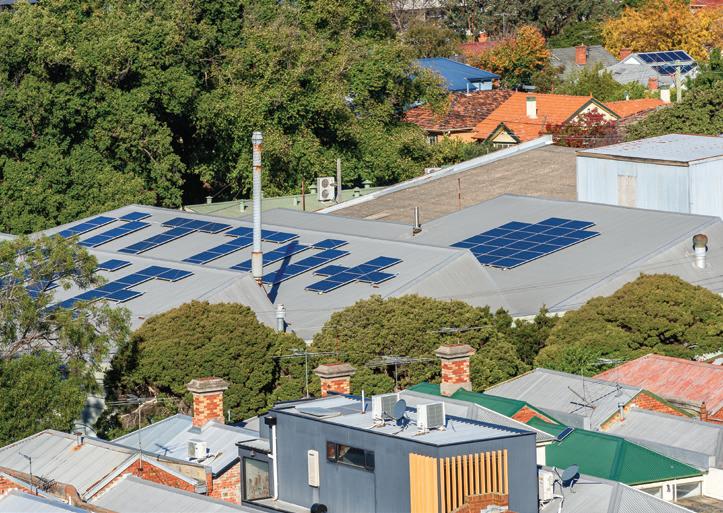
dire predictions about the prospects for the large-scale renewable energy industry.
However, the sector was able to ride through most of these challenges, completing 32 projects with a capacity of almost 2GW throughout the year. A further 76 large-scale renewable energy projects were under construction at the end of 2020, representing more than 8GW of new capacity and employing over 9,000 Australian workers, often in regional areas. Of these projects, 49 were large-scale solar farms, 21 were wind farms and three were bioenergy plants.
A further three were hybrid plants, producing at least two different types of renewable energy. Despite making up just over a quarter of all projects under construction, the wind sector is responsible for over half of the new capacity, with more than 4GW of new wind generation currently being built.
The utility-scale battery sector saw a number of significant developments in 2020. The most notable of these was the expansion of the Hornsdale Power Reserve to 150MW/194MWh, which will allow Australia’s biggest battery to provide additional grid support services such as inertia to help stabilise the grid.
An additional 16 utility-scale batteries were under construction at the end of 2020, representing more than 595MW of new capacity. Several new major project announcements in 2020 provided a further
boost to the sector, including a 300MW battery in Victoria, Western Australia’s first large-scale battery, and a plan to install a mammoth 1.2GW battery in New South Wales’ Hunter Valley.
The development of Snowy 2.0 and the Battery of the Nation hydro projects continued to make steady progress in 2020. Snowy 2.0 received state and federal environmental approval during the year and a $125 million transmission investment from the Clean Energy Finance Corporation, putting the project on track to begin construction in 2021. In Tasmania, the Battery of the Nation named its first pumped hydro site, while Marinus Link – the interconnector that is a critical component of the project – received a $94 million commitment from the Federal Government.
The large-scale sector faced its fair share of obstacles during the year. The most prominent challenges continue to be related to the electricity grid and the lack of a federal energy policy, with the convoluted grid connection process, network congestion and energy policy inaction causing significant uncertainty for developers. While reform initiatives such as the Energy Security Board’s post-2025 market review are working to alleviate grid-related issues, and state and territory governments are taking energy policy into their own hands, it will take significant time and effort to solve the problems caused by years of inaction and neglect.
www.energymagazine.com.au June 2021 ISSUE 14
27 FUTURE ENERGY This is an extract from the Clean Energy Council’s Clean Energy Australia report for 2021, reprinted with permission. To read the full report, head to the Clean Energy Council website, www.cleanenergycouncil.org.au
The small-scale solar sector showed no sign of slowing down in 2020, as more than 3GW of new capacity was added to Australian rooftops.
7 STEPS TO MAXIMISE BATTERY RETURN ON INVESTMENT

Lithium-ion battery costs are tumbling. But large stationary storage systems still involve high capital outlays, which is why investors and asset owners need to find ways to improve their return on investment.
The flexibility of modern battery storage systems is such that there are often many ways an asset can pay for itself, irrespective of whether it is located in a front-of-meter or behind-the-meter (BTM) setting. The key is to plan your battery deployment to maximise return on investment (ROI) from the outset – here are our seven best tips for doing this.
1. Consider all possible revenue streams
If you are investing in an energy storage system, then the chances are that you have a specific application in mind, such as delivering front-ofmeter frequency response services or improving solar energy selfconsumption in a BTM deployment.
However, batteries can usually deliver multiple services – and each one can contribute to the profitability of the asset. Don’t leave any stone unturned when considering the revenue streams your battery can generate.
4. Design your battery system for optimum ROI
Once you have a clear idea of where you will achieve the greatest value from battery storage, you are in a position to optimise the system design for ROI. Factors such as cycle rates and average depth of discharge will have an impact on how your system should be configured.
5. Be careful in selecting your supplier
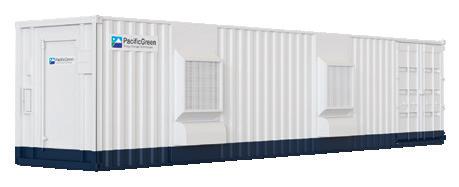
It is important to select tried-and-tested battery technology and have it installed by a trusted, experienced engineering, procurement and construction contractor.
At Pacific Green Energy Storage, for example, we have a team that has overseen the installation of more than 380MW and 1.3GWh of battery capacity across more than 30 countries.
6. Configure and operate your system for the best returns
2. Think about total system benefits
Batteries cannot charge and discharge unless they are connected to other assets, so when looking at ROI, it makes sense to consider a battery as part of a larger system. If deployed alongside PV, for example, a battery can help maximise the utilisation of your grid connection.
3. Model your system before investing
It is important to seek expert help in modelling the benefits of different applications. Going through this exercise can help you assess the ideal battery configuration for the applications that will yield the greatest value, work out the total ROI, and identify the highest-value application(s).
Batteries are amazingly versatile assets, but to realise the value they can offer, you need to set them up and run them in the right way. Energy arbitrage, for example, could provide a valuable income stream, but to take advantage of it you need your battery to be able to respond to market pricing.
7. Make sure you have a maintenance contract in place
In theory, batteries should be able to deliver many years of solid performance with minimal maintenance. In practice, even the most reliable products in the world can sometimes fail, and if that happens you need to make sure your profitability is not affected. Having a maintenance contract in place ensures that even if things go wrong, you’re protected and able to get your asset back up and running – and delivering you profits again.
Pacific Green Energy Storage are experts in scalable, turnkey battery energy storage systems. To learn more about their systems, and for more tips on getting the most out of your battery installation, visit www.pacificgreen-es.com.
June 2021 ISSUE 14 www.energymagazine.com.au 28 FUTURE ENERGY SPONSORED EDITORIAL
Satellite Internet for Remote Operations
Australian Private Networks supplies fixed and portable internet solutions for utility operators in remote Australia.
Our solutions include:
Unlimited data plans
Low contention rates
Fixed or portable hardware
Solar, self-sufficient options
Optional Extended Wi-Fi and Public Wi-Fi
Installation & Field Support Australia-wide
O Our solutions overcome the communications limitations of operating in remote locations
With our internet services, staff can access online business tools, operations can integrate remote monitoring tools and utilise IoT technologies.
No matter your communications challenge, we can design bespoke solutions to meet your unique requirements.
For more information contact our Corporate Sales team or visit: apn.net.au

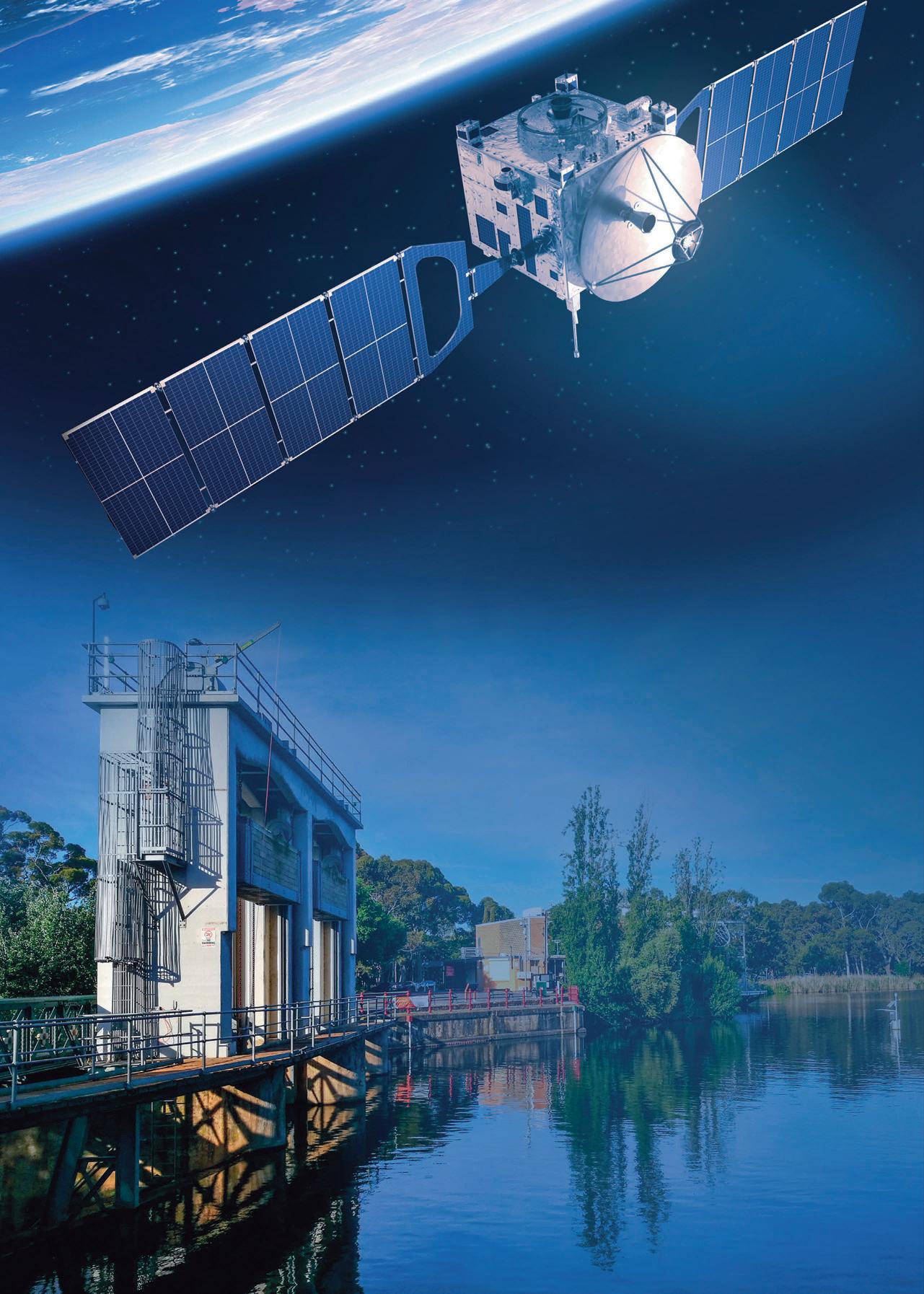

Major Partner Contact Us 03 8566 8312
FUTURE

PATHWAYS FOR AUSTRALIA’S ENERGY TRANSITION
June 2021 ISSUE 14 www.energymagazine.com.au
30 FUTURE ENERGY
Future Energy 2021 is a landmark, ten-day Summit taking place over June and July, bringing together leaders from Australia’s energy industry to share their insights and perspectives on the rapid transformation of energy in this country.
This fully virtual summit is being organised by Energy Magazine. Over the ten-day conference period, we will run four free-to-attend virtual conferences that will cover critical interest areas relating to the future of the energy industry.
Attendees will enjoy first-hand accounts and experiences from the people at the forefront of the transition, as well as insights from those leading the design of our transformed market.
The four conferences that will be held over the course of the summit are:
June 29 – Hydrogen strategy: exploring the pathways to use and export
An in-depth look at Australia’s emerging hydrogen industry, and the work being done to develop domestic and export markets for this fuel.
July 1 – Future grid: managing the integration of renewables into the grid
Diving deep into what Australia’s future energy grid will look like. We’ll cover the exit of coal, integration of renewable energy, and the ways the grid will need to adapt to meet our changing energy mix.
July 6 – Big batteries: backbone of the modern grid
An exploration of the big battery projects underway around Australia from some of the biggest players in the space.
July 8 – Renewable energy zones: powering Australia’s future
We profile Australia’s emerging renewable energy zones, and provide an update on how planning and construction is progressing at sites around the country.
Each individual conference will feature a range of expert speakers, as well as a panel discussion, covering the critical issues in each area.
First round speakers
The first round of speakers has been announced for the Future Energy Summit, and includes:
» Leigh Kennedy, National Hydrogen Technology Cluster Manager, NERA
» Gabrielle Sycamore, General Manager - Renewable Gas, Jemena
» Andrew Dillon, Chief Executive Officer, ENA
» Bruce Hansen, Gas Manager, Evoenergy
» Parvathy Iyer, Senior Director, Infrastructure Ratings, S&P Global Ratings
» Tom Culbert, Senior Manager, Accenture Strategy
More speakers will be announced as the conference draws closer. Keep an eye on Energy Magazine’s social channels to stay up to date with all our new speakers as they are announced.
More than just a webinar
We understand that one of the main benefits of attending a conference is the ability to engage with speakers and other attendees. That’s why we are establishing a dedicated online community for all Future Energy attendees.
Through this platform, all attendees can reach out to new connections, exchange details and share ideas. Now, more than ever, people are seeking out new ways to connect with industry cohorts and collaborators, and our online community allows you to engage virtually.
Stay ahead of the curve
When an industry is in transition, it can be challenging to stay up-to-date with all of the changes that are happening. It’s easy to focus on your own role in the industry and miss important opportunities to learn, grow and collaborate.
The Future Energy Summit offers members of the energy industry a unique opportunity to stay ahead of the curve; and the fact that it is being delivered virtually means that anyone can attend and enjoy the benefits the summit will have to offer.
Importantly, the summit is also free to attend for anyone working at a utility, within government or at a not-for-profit. At Energy Magazine, our focus has always been on sharing high quality information that enhances the professional lives of our audience, and the Future Energy Summit is no different. We look forward to seeing as many of you as possible logging in for the event, and sharing the knowledge with our expert speakers with you then.
www.energymagazine.com.au June 2021 ISSUE 14 31
FUTURE ENERGY
GIVING NEW LIFE TO AGING WIND TURBINES

As large and complex assets, wind turbines can present considerable challenges when it comes to maintaining their reliability as they age. Working with an experienced and reliable aftermarket partner that uses genuine parts can prolong the life of wind turbines and ensure they continue to deliver clean energy for years to come.
In general, wind turbine generators will have a warranty period of up to 10 years – which means that around the world, many wind turbines are reaching the end of their maintenance period.
While reaching the end of a warranty period can be a cause for concern for asset managers, it doesn’t need to be. In fact, in many ways, it can be an opportunity to assess their condition, consider improvements and extend the service life of an asset (which in turn further reduces its carbon footprint).
Wind turbines operate in particularly harsh environments, which places considerable pressure and stress on the equipment during operation. For example, strong and unsteady winds and gusts can cause skidding or excessive loads, while ambient moisture can create a corrosive atmosphere and lubricant degradation.
Once the warranty period for a wind turbine expires, maintenance becomes critically important. Major and expensive components start to reach the end of their service life and need to be refurbished or replaced.
Adding to the challenge is the fact that inspection and maintenance activities on wind turbines are particularly laborious and costly, as the defective equipment may be located over one hundred meters above the ground and exposed to changing winds. For offshore wind farms, access becomes an even greater challenge.
Furthermore, the warranty and service contracts can often prevent turbine owners and operators from thoroughly understanding their equipment and how to effectively inspect and maintain it, as these tasks are performed by the contractor appointed under warranty. As a result, at the end of the warranty period, operators will often find themselves exposed to high maintenance costs and prolonged downtime as service contracts are no longer valid. In these cases, many operators may feel resigned to decommissioning turbines, or at the very least, undergoing expensive reparation operations.
A new lease on life
However, there is an alternative to these costly options. Turbine owners and operators can team up with an OEM Service partner who will offer products that can provide a high-quality, cost-effective solution to obtain genuine spare parts or to upgrade the equipment. In this way, it is possible to extend the service life of wind turbines, improving the overall performance and reducing maintenance costs.
Altra Industrial Motion provides technically advanced products to satisfy the complex and challenging needs of the wind power industry. The many brands within Altra Industrial Motion, such as Matrix, Svendborg Brakes, Stromag, Ameridrives, Warner and Twiflex, have extensive experience in engineering and manufacturing integrated solutions for the wind energy sector.
The products provided by Altra Industrial Motion are designed with as few moving parts as possible in order to simplify and reduce maintenance. Also, the components can be customised to address the specific needs of each wind turbine project and improve the overall turbine performance. In addition, when specialist equipment is necessary, the company is able to design, manufacture, test and supply brand new apparatuses, thanks to in-house facilities and experts.
Choosing Altra Industrial Motion solutions doesn’t just mean purchasing high-quality, customisable components that can be easily maintained – once the genuine spare products are delivered, Altra Industrial Motion provides fundamental support, providing operators with training and guidance on how to perform preventive and responsive maintenance for onshore wind turbines. In this way, the on-site personnel have the chance to understand their equipment and learn to repair its parts in the event of failure.
As with any rapidly adopted technology, wind power presents evolving challenges that need solutions in short time frames.
With the advent of aftermarket wind turbine solutions, asset owners and operators can overcome problematic maintenance procedures, reduce local environmental impact and maximise reliability for wind turbines.
In doing so, wind turbine owners can fulfill the inherent potential within their assets and further enhance the sustainable benefits they offer.
June 2021 ISSUE 14 www.energymagazine.com.au 32 FUTURE ENERGY SPONSORED EDITORIAL





































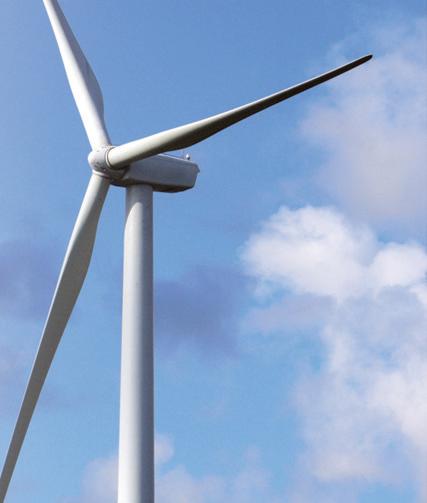














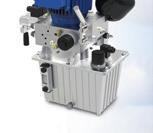








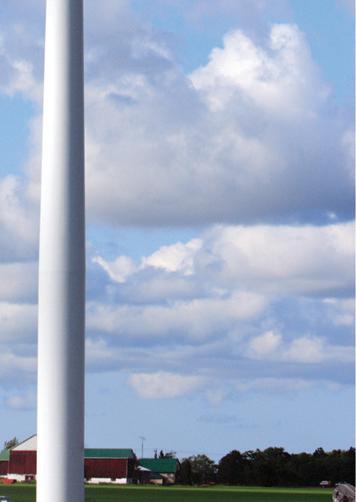
STATE GOVERNMENTS NEED TO WORK TOGETHER
TO PLAN RENEWABLE ENERGY POLICIES
by Franklin Liu, Senior Policy and Regulatory Consultant, Cornwall Insight Group

June 2021 ISSUE 14 www.energymagazine.com.au 34 ENERGY NETWORKS
As Australia’s energy market transitions, many state governments have stepped up with more progressive policies than those offered by the Federal Government. However, Franklin Liu warns that unless our state governments can work together to utilise their comparative advantages, we may be facing a number of key challenges across the National Electricity Market.

www.energymagazine.com.au June 2021 ISSUE 14
35 ENERGY NETWORKS
When announcing popular infrastructure policies, governments can often get caught up in the idea that the policy might not be big enough. Another concern might be that someone else will be announcing an even bigger policy or project. Recently, this mentality seems to be driving state governments as they try to outbid each other with ever more ambitious renewable energy targets. As of November 2020, all eastern state governments have committed to a headlong charge towards their renewable targets by 2030.
Here’s a quick summary of where the states are at:
» Victoria and Queensland have committed to a 50 per cent renewable target, including distributed and utility-scale renewable generation
» Tasmania will produce 150 per cent renewable energy relative to its demand, an interim step to its 200 per cent target in 2040
» South Australia will deliver net 100 per cent renewable generation by 2030
» NSW announced its Electricity Infrastructure Roadmap, which will build 12GW renewable capacity, in addition to projects that have already been committed
In the absence of any meaningful climate change policy at the federal level, it is admirable that both Liberal and Labor state governments have stepped forward and answered the call from their respective electorates.
However, it must be remembered that all eastern Australian states belong to an interconnected system called the National Electricity Market (NEM). Policies announced by one state will inevitably affect all other NEM participants as electrical flows respect no artificial state boundaries. Unfortunately, it appears that the states have not examined the overall impact of their policies. Without coordinated planning, they might inadvertently run in each other’s way when racing towards their 2030 renewable targets.
Figure 1 examines the impact of the states’ renewable policies on the overall NEM demand-supply profile in 2030. We start with the 2020 time-of-day average generation profile by fuel type in each state. We then increase the renewable profiles proportionally in each state to meet its renewable target and
subtract coal and gas that are projected to retire based on the system operator’s (AEMO) data or confirmed announcements (such as Yallourn). It is currently unclear how South Australia will achieve its net 100 per cent renewable target. This is because AEMO currently requires at least two thermal units in the region to be online at any time for system security reasons. Therefore, we have not incorporated the impact of its net 100 per cent renewable target in the chart, but only included its committed new renewable projects and announced retirement.
To illustrate the challenges as well as opportunities, the chart starts with a static view by keeping the average shape for each fuel type constant, but we will discuss the impact of market responses, including storage investment and thermal retirement later. As households install more rooftop PV and battery, the future demand pattern will continue to change. The red traces, based on AEMO’s estimate, shows the 2030 demand pattern.
The starkest pattern in 2030 is that every region will have excess energy in the middle of the day. As all NEM states are more or less located along the same longitude, all solar devices (rooftop and utility-scale) will reach their peak output at around the same time. The result is that across the whole NEM, there will be close to 12,000MW excess energy on average waiting to go somewhere. And unfortunately, interconnectors are of no help if all regions are trying to export to their neighbours. The importance of the average qualifier should not be overlooked here, as it means for roughly half of the year, the actual midday excess supply will be even more than 12GW.
What’s the solution?
Before we go any further, let us be crystal clear here. This article is not trying to sell a doomsday, anti-renewable prophecy. Various solutions can be found at different timeframes to manage the excess supply, which we will discuss below.
First, if this does happen, the system operator (AEMO) will act as the last line of defence. Its dispatch engine balances the market every five minutes by ensuring supply exactly equals demand. When there is too much supply, it will ask some generators, including renewable units, to reduce their output. This is normally done via the more orderly market process to reduce output from generators with the most expensive offers first. However, AEMO
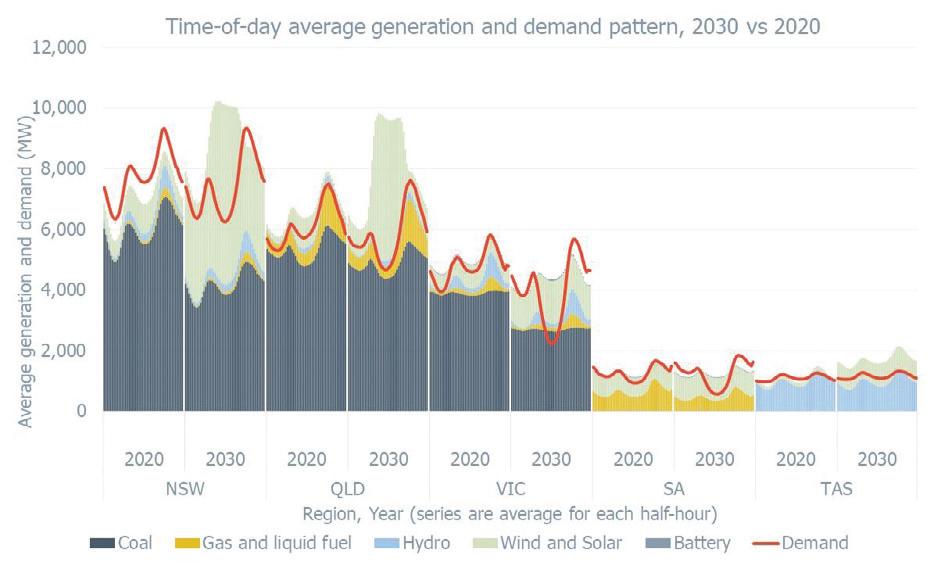
June 2021 ISSUE 14 www.energymagazine.com.au
36 ENERGY NETWORKS
Figure 1. Source: Cornwall Insight Australia.

could constrain certain units out of the merit order for various system security reasons, often presenting an “un-hedgeable” risk to affected participants. AEMO could also turn off rooftop PV to increase demand in a region (as the affected households have to source their energy from the grid). While this is a rather blunt measure, AEMO has already been forced to use it recently to manage record minimum demand in South Australia caused by continuous strong rooftop PV uptake.
However, curtailment of renewable energy is wasteful in terms of both the lost green energy on the day and the massive upfront capital cost spent to build these assets. If such curtailment were to happen regularly, the states would effectively be blocking each other’s path in their individual pursuits for bigger renewable energy targets. So, could things be done earlier to prevent this?
The invisible hand of the market could be relied upon to an extent. Excess supply at midday will suppress wholesale energy price during that time, which creates a powerful incentive for investment in storage assets. Storage can soak up the cheap energy at midday and sell it later when prices are higher. While battery and pumped storage are proven technologies, recent developments in hydrogen offer even more options. Excess energy can now be packed up and transported to a different location to be consumed later. With more storage, the midday generation peak will be flattened as more green energy is transported to late evening or overnight. However, the several gigawatts of storage projects currently in the pipeline (the exact number depends on the counting criteria) will still face the mountainous challenge of moving the average 12GW excess energy in the whole NEM.
Renewable energy will also push out coal and gas. It is now widely agreed that the exit of thermal plant will be faster than initially expected, and the survivors will be forced to find different operating patterns. The retreat of fossil fuels will likely shrink the dark and yellow stacks in the chart to make more room for renewable energy. However, as of now, the mainstream forecast (including that of the system operator) still expects the majority of thermal retirement (which is more than just coal) to occur after 2030. Therefore, there will likely be a few years where the thermal fleet will struggle to stay online and compete with renewables for the limited dispatch room.
Finally, while purist economists or market designers sometimes hate to acknowledge this, governments will not leave the energy market alone for various reasons. We will continue to see government policies change the course of the NEM over time. Therefore, it is upon the states to plan things better by taking a more holistic, NEM-wide view together whenever they decide to influence the electricity market. For example, states could build less grid solar in favour of more wind, as the former would inevitably compete with rooftop PV for limited midday demand. The latter’s flatter shape might be a better substitute for retired baseload plant.
And when planning renewable energy zones, the states should not solely focus on building more transmission to connect more renewable capacity. Instead, more effort should be spent on managing the renewable output and reducing their curtailment risk, which could be done by building storage and installing appropriate grid support equipment.
The states also need to be awakened to the fact that the NEM is an interconnected market for regions to trade. This means specialising in things one has a comparative advantage in, instead of just building everything bigger than one’s neighbours. For example, rather than focusing on delivering more green energy within their borders, some states could build more pumped storage, and others might focus on hydrogen facility development. (Although it looks like there is a risk that all states might rush to develop bigger hydrogen plans given it is the buzzword of the day.) This would help them manage not just their own but also their neighbours’ excess energy, which could support more renewable generation across the whole NEM by reducing wasteful curtailment.
Trade and coordination via the market allow states to save capital expenditure on their marginal, less gainful projects and divert them towards more productive purposes. This will likely lead to Australia achieving the same overall emission reduction objective at a much lower cost.
When it comes to electricity market design, the idea that “the whole is greater than the sum of its parts” should be the ultimate pursuit of not just engineers, but policymakers as well.
Franklin Liu is a Senior Policy and Regulatory Consultant in Cornwall Insight’s Australia office. He has close to ten years’ experience in the Australian electricity market and has worked both in the consulting and public sectors. Franklin’s current role focuses on regulation, policy and market insights across the Australian energy supply chain, including wholesale, network and retail sectors. He leads Cornwall Insight Australia’s regulatory and market insight products such as Energy Market Perspective, Market Alerts, Energy Spectrum Australia and Energy Market Executive Summary.
www.energymagazine.com.au June 2021 ISSUE 14 37 ENERGY NETWORKS
Franklin Liu suggests that some states should favour wind energy, as a way to balance all of the solar generation in the NEM.
THIS PRICE IS DEFINITELY NOT RIGHT
by Tamatha Smith, General Manager, Corporate Affairs, Energy Networks Australia

While the ACT’s target of 100 per cent renewables is admirable, it has had unintended consequences other jurisdictions should be aware of.
38 ENERGY NETWORKS
A network price increase of 40 per cent from one year to the next is almost unheard of – but it is about to happen to the Australian Capital Territory’s (ACT) electricity customers.
Evoenergy’s pricing proposal for 2021/22 was released by the Australian Energy Regulator in early April and it tells a cautionary tale about how state-based policies can very quickly turn on their customers.
According to the proposal, the cost of the ACT’s large-scale feed-in tariff, a territory policy (known as a jurisdictional scheme), will increase by 133 per cent on 1 July 2021 from $65 to $153 million. Legislation requires this charge to be administered by Evoenergy and recovered in network charges. Across a customer base just north of 200,000 households, it is going to be a big hit to hip pockets. Residential network charges are forecast to increase by almost $300 a year.

How did we end up here?
The ACT Government legislated in 2016 to source 100 per cent of all Canberra’s electricity from renewable sources by 2020. To reach the 100 per cent renewable electricity target, renewable energy is purchased and offset through ‘contracts for difference’ under the large-scale feed-in tariff scheme from wind and solar farms mostly outside of the ACT.
‘Contracts for difference’ effectively lock in the price of electricity paid to renewable generators for a period, irrespective of what actual wholesale prices are. They are a tool to give certainty to renewable generators, ensuring they will be commercially viable if constructed.
Renewable generators make payments to Evoenergy if the wholesale price is above that specified in the contract, while Evoenergy makes payments to renewable generators if wholesale prices fall below the price specified in the contract.
Several contracts have been struck since 2014, at an average of about $90/MWh. Wholesale prices have plummeted in 2021, averaging $35-$40 to date. Normally that would be cause for rejoicing, but ACT customers will not see the benefits because they’re effectively paying fixed wholesale prices of $90/MWh.
Payments from Evoenergy on behalf of the ACT Government to renewable generators have totalled $146 million to September 2020.
Unfortunately, there is no end in sight either, given the contracts have a period of between 10-20 years. ACT customers will continue to pay $90/MWh until the contracts expire.
A cautionary tale
While 21 per cent of the payments ACT customers make to source renewables are mandatory under the national Renewable Energy Target, the ACT Government pays the remainder voluntarily to meet its own 100 per cent renewable energy target.
Other states are also going it alone on energy policy, with Victoria and NSW joining the ACT in carving their own path.
While it is the prerogative of each jurisdiction, departures from national frameworks can have unintended consequences on customers, with the ACT’s large-scale feed-in tariff scheme a case in point. The sheer magnitude of customer impact from this single policy provides a cautionary tale about opting for bespoke state policies, rather than developing least-cost national solutions.
Irrespective of the intent, a key policy design question is whether any government should use an electricity network company to administer and achieve its broader policy objectives – in the ACT’s case its 100 per cent renewable energy target.
Where does that leave us?
A government scheme being the driving factor in a 40 per cent increase in network prices over a single year is cause for concern. Given the length of the contracts for difference, these price increases are likely to be a feature of electricity bills over the foreseeable future without legislative changes to protect ACT customers.
This policy is the first major customer pain point to develop from states going it alone with their own policies.
Designing long-term nationally coordinated policy that lowers costs for all customers is not easy, but it is preferable to a piecemeal approach of state and territory governments going it alone. In the volatile, transformative environment that defines our energy system, there is very real risk that bespoke state-based policy decisions could have unintended consequences that hurt customers.
The ACT’s price increases could be a sign of things to come for others unless lessons are learned.

www.energymagazine.com.au June 2021 ISSUE 14
39 ENERGY NETWORKS
Energy Networks Australia welcomes feedback on this piece –get in touch with author Tamatha Smith at tsmith@energynetworks.com.au
Figure 1: Actual Evoenergy network charges compared to the proposed new charges.
Figure 2: Cumulative payments to generators under the large-scale feed in tariff scheme.
WASTE NOT, WANT NOT: PREPARING FOR AUSTRALIA’S SOLAR WASTE PROBLEM
By Eliza Booth, Associate Editor, Energy Magazine

40 STORAGE AND SOLAR

Australia now has the highest proportion of household photovoltaic (PV) systems in the world thanks to government rebates and falling costs of installation. But what happens when solar panels reach the end of their energy-producing life and need to be replaced? How do we manage an ever increasing amount of renewable generation waste while still encouraging the uptake of renewable? Energy magazine spoke with Professor Peter Majewski, Research Professor in Advanced Materials at UniSA’s Future Industries Institute, who, along with fellow researchers and industry across Australia, are leading a national push to establish a lifetime stewardship scheme for Australia’s PV industry before it peaks.
With more than 21 per cent of Australian homes –around 2.6 million – now possessing a solar energy system as of December 2020, and many solar farms currently operating or under construction across the country, Australia is leading the world in the uptake of public and private solar energy generation. And it’s not surprising to see why Australians are so excited about solar energy – our country is the ideal location to reap the benefits from clear solar energy.
However, as solar PV panels continue to be installed in homes and across solar farms, a new issue is presenting itself to industry and government – what will we do when these solar PV panels reach the end of their useful life?
Why do we need to recycle?
The popularity of solar PV panels has skyrocketed in recent years with average cost of installation starting from around $3,500, however, prices are steadily coming down even further with demand and production increasing, making them more accessible than ever.
The industry standard lifespan of solar panels made of silicon is around 25 to 30 years, and with the uptake increasing each year, government and industry realised that a peak of PV panels reaching the end of their life is fast approaching. As PV panels are classified as e-waste, they cannot be disposed of in landfill, meaning that there needs to be a more specialised plan for disposal and recycling in place to properly manage waste.
“People realised, about five years ago maybe, that solar energy is still clean in terms of not producing greenhouse gas emissions, but you will have solid waste at the end of the productive life of the things,” Professor Majewski told Energy magazine.
Professor Majewski said from here the realisation that something needed to be done to prepare for the inevitable peak in renewable generation waste came about from discussions between government, non-government organisations and academics. The government came on board when it realised the importance of end-of-life management for the waste that would be left over from PV panels. To assist in the planning of recycling and managing waste, the government added PV technology to the National Waste Policy Action Plan, which outlined the need to implement effective product stewardship for priority products including batteries and PV systems.
According to Professor Majewski, this was a clear signal to stakeholders that everyone needs to look into waste management and recycling seriously and prepare action plans before the peak. To achieve this there needs to be strong government backing and legislation to encourage industry to invest in and plan for recycling and waste management of PV panels, otherwise they may disregard this need as something to think about further down the track.
“These product stewardship schemes, or the development of the product stewardship schemes, are usually labelled as industry led. So the government wants the industry to lead the development of the product stewardship scheme in order to ensure that they have a big say,” Professor Majewski explained.
June 2021 ISSUE 14
41 STORAGE AND SOLAR

“The product stewardship scheme is set up in a way that it’s not harming or penalising the industry for doing something which everybody wants to have. We have good quality, low price solar PV panels. The industry has to work with the government in order to ensure that the end-of-life management is secure.
“The government wants to have a lot of consultation with manufacturers, with installers, with electricians, and researchers to ensure to get the best product stewardship scheme out of this process, and they are very keen to have a voluntary product stewardship scheme.”
This voluntary scheme would be similar to those already established for other types of e-waste like computers, batteries and electronics, and would encourage collaborative involvement from the industry to tackle the issue.
Where are we at now?
Realising the need for a coordinated approach to recycling and managing solar PV waste is only half the battle, and we are still a ways off in terms of being fully prepared for the peak of waste from these technologies. So, where does Australia
currently sit with managing PV waste and how does it compare to the rest of the word?
“In Europe there’s a lot going on. They have big companies involved like Veolia, for example, who are running recycling plants in France for solar PV panels. Here in Australia we have, I would say, an emerging industry.”
Professor Majewski explained that there are multiple different parts of PV panels that can be recycled, such as the solar cells. However, there are other portions of the panel that are very difficult and environmentally not sound to recycle or repurposed, such as the plastic components, presenting a more difficult issue to solve.
“Not all solar cells in the panels are damaged or destroyed once the panel is not working anymore. You can recover the working cells and build new panels out of it, or smaller panels for different purposes.
“They have some components like plastic or the back sheet – the weatherproof sheet for the panel – which is going to be very difficult to recycle because it’s plastic and there’s very limited scope.”
Although there are components that present more of an issue for waste management than others, that doesn’t
mean that there aren’t companies diving into recycling for solar panels already. In February of 2021, solar panel recycling company Reclaim PV Recycling announced its plans to establish its first solar panel recycling processing facility in the Adelaide suburb of Lonsdale, in South Australia. The plans estimated that the facility would be able to recycle tens of thousands of PV panels a year.
Following this, a new solar panel recycling facility opened in Thomastown in Melbourne’s west by energy co-operative, Lotus Energy. The facility claims it is able to recycle 100 per cent of end-of-life solar PV modules, saying in a press release in September 2020 that the facility was able to recycle all materials recovered from the PV panels like solar modules, inverters, cables and batteries for alternative use, leaving no waste for landfill.
However, it’s not just PV panels that are testing the ability to be recycled. Another renewable energy generation technology is presenting a challenge for researchers and industry – wind turbines. The blades of wind turbines are large and notoriously difficult to recycle, being made out of steel and fiberglass, which is banned from landfill.
June 2021 ISSUE 14 www.energymagazine.com.au
42 STORAGE AND SOLAR
“These blades are the size of an airliner wing, and they have been built to withstand hurricane-force winds, so they are a big challenge when they get to the end of their life,” Professor Majewski said.
“As with solar panels, that disposal challenge requires planning and preparation, but approached the right way it doesn’t have to be an insurmountable problem, and we are beginning to look at strategies for how to deal with these blades as they come offline.”
Between PV panels and wind turbines, it’s clear that more needs to be done to address the increasing peak of renewable energy waste and ensure our efforts to shift to more sustainable energy generation isn’t at the expense of an increase in waste.
What more needs to be done?
Looking to the future of solar PV panels and recycling, Professor Majewski said that getting the design right at the manufacturing level will be key to ensuring proper disposal at the end of the panels’ life cycle. This can include making the panels easier to disassemble and also avoiding materials that are not recyclable, like the plastics currently being used, creating a true circular economy in the renewable space. However, Professor Majewski cautions that changing the manufacturing process significantly could be a double-edged sword.
“The future research should move towards design for recycling, so that the design of the panels and manufacturing processes for the panels have in mind that they need to be recycled at one stage, which could include easier assembly of the panels. If they’re easier assembled, you can more easily disassemble the panels. This helps recycling,” Professor Majewski explained.
“There’s research worldwide going on in this area, but as long as the industry doesn’t see a financial benefit of … using new materials or a change in the current manufacturing process, then they wouldn’t do this.
“It’s a situation where a lot of people understand we have to change something in order to make them more recyclable but on the other hand, we don’t want to disrupt the manufacturing and distribution of solar panels because we want to have it in order to reduce the greenhouse gas emissions.”
Hopefully with the proposed stewardship scheme in Australia, recycling, reusing and disposing of PV panels can be undertaken in a more economical and safer way, without disrupting the manufacturing process too greatly.
The ideal outcome for Professor Majewski would be having a scheme that is agreed upon by all stakeholders involved. From here a product stewardship
organisation can be developed to overlook operations and ensure that all parties involved are doing the right thing and recycling in the proper ways.
For Professor Majewski, the key to successfully curbing renewable waste is starting the planning now, before the dream of lower emissions turns into a nightmare.
“We have time to plan for this and ensure the processes are in place, but we have to start acting now, as the right practices may take some time to implement,” Professor Majewski said.
References:
https://www.energy.gov.au/households/solar-pv-and-batteries
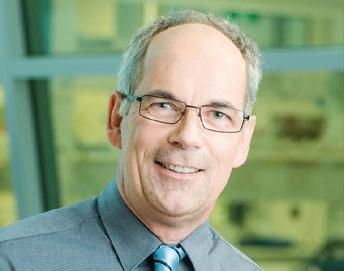
https://www.environment.gov.au/system/files/resources/5b86c9f8-074e-4d66-ab11-08bbc69da240/files/national-waste-policy-action-plan-2019.pdf
https://reneweconomy.com.au/australias-first-solar-panel-recycling-facility-to-be-established-in-adelaide/
https://www.lotusenergy.io/post/solar-panel-recycling

www.energymagazine.com.au June 2021 ISSUE 14 43 STORAGE AND SOLAR
Professor Peter Majewski.

June 2021 ISSUE 14 www.energymagazine.com.au 44 STORAGE AND SOLAR
RAYS THE ROOF:
ACCOMMODATING HOME SOLAR AND BATTERIES INTO THE GRID
by Imogen Hartmann, Associate Editor, Energy Magazine
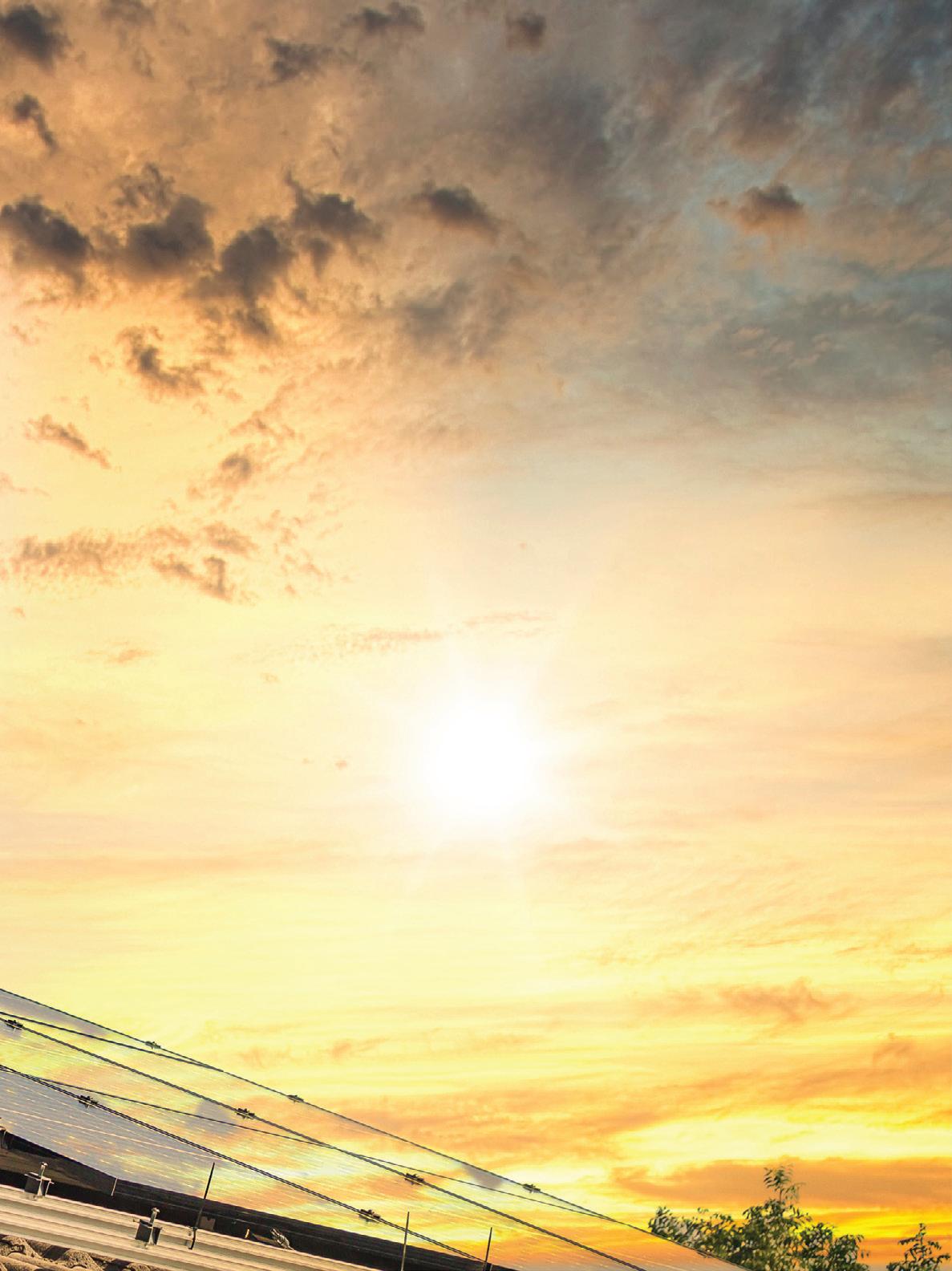
Australian energy users are taking to distributed energy resources like home solar and batteries at a rapid pace, and while small-scale solar and renewable options will help to decarbonise the electricity sector in a way that’s both fast and economical, the rapid uptake of these technologies is causing ‘traffic jams’ in the network. Here, we examine the Australian Energy Market Commission’s plans to safely and efficiently integrate more home solar and batteries into the grid.
www.energymagazine.com.au June 2021 ISSUE 14
45 STORAGE AND SOLAR

Australia’s aging energy infrastructure means that our system is ill-equipped to handle power flowing both to and from consumers. This means that a significant amount of solar potential is inaccessible, leaving consumers unable to export their solar energy because of daytime ‘traffic jams’ on the network.
Though this issue doesn’t currently affect all solar owners, it is worsening, and inaction will result in the system reaching its technical limits, forcing power networks to severely limit power exports or build expensive new poles and wires to cope with the new solar on its way.
According to Australian Energy Market Commission (AEMC) Chief Executive, Benn Barr, there are clear benefits to making the adoption of home solar and batteries more accessible to customers, but to do that “we need to make some changes to the power system”.
“Within ten years, half of all energy users will be using home energy options like solar,” Mr Barr said. “We must make sure this seismic shift doesn’t leave anyone behind because every Australian, whether they have solar or not, deserves an affordable, sustainable power system.”
As part of the Australian Renewable Energy Agency's (ARENA) Distributed Energy Integration Program, consumer representatives, industry associations and energy market bodies and other stakeholders worked with the AEMC over nine months, with the aim of maximising the value of customers’ distributed energy resources (DER). As a result, the AEMC was to change the rules, and has since handed down its draft determination.
Reforms at the network and customer level
The AEMC’s draft determination outlines the following reform package:
1. Adjusting distribution networks’ existing incentives: This entails shifting the incentives to focus on services that support people in sending power back into the grid. This is expected to provide networks with more reason to deliver valuable export services to customers. Currently, there is a lack of financial penalties for inadequate network export service, and little recompense for quality service.
2. Official recognition of energy export as a power system service: The AEMC also proposes the recognition of energy export as a service to the power system in the energy rules, to provide consumers more agency over what and how export services networks deliver.
3. Allow two-way pricing offers from networks: By providing networks with new pricing options, such as rewards for sending solar and battery power to the grid in times of high demand, customers have more incentives to purchase batteries or use the power they generate during peak grid times.
4. More flexible pricing at the network level: This would facilitate a menu of price options, designed by each network, based on their capability, customer preferences and government policies. This would enable more choice for customers, such as free export up to a limit or paid premium services that lock-in export during busy times.
“This is about creating tailored options, not blanket solutions,” Mr Barr said. “We want to open the solar gateway so more Australians can join the 2.6 million small solar owners who have already led
June 2021 ISSUE 14 www.energymagazine.com.au 46 STORAGE AND SOLAR
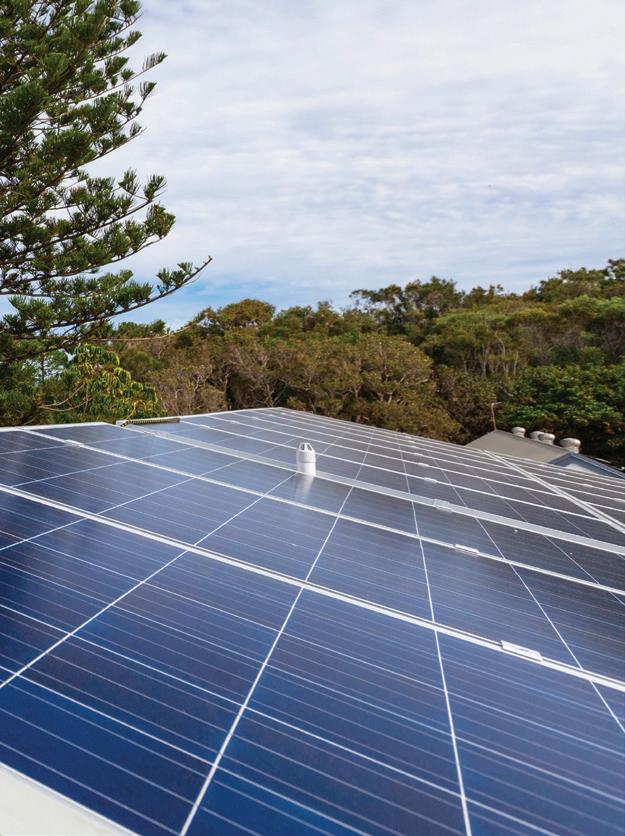
the way. But it’s important to do this fairly. We want to avoid a first in, best dressed system because that limits the capacity for more solar into the grid.
“One option to deal with more solar traffic – building more poles and wires – is very expensive and ends up on all our energy bills whether we have solar or not. While the sun may be free, the poles and wires aren’t, so we think the key is to use the power system smarter to avoid costly overinvestment and keep new infrastructure to a minimum.”
What does a smarter power system look like?
A smart system will improve the flow of electricity in the power system, minimise impacts of demand peaks and troughs throughout the day, and capitalise more from the poles and wires already in place. Successful integration of DER into the electricity system would see renewables connected to the grid in a way that makes the most of the ‘network platform’, and allocates costs in an efficient way.
High-quality export services – those that support consumers to export their power and take advantage of technology to do so –would be central to a smart power system. The AEMC likens this to technology many consumers are already familiar with – a Google Nest. A high-quality export service might look similar to a smart home energy management system such as Google Nest, by providing networks with the data they need to identify what’s happening with the power flow. From there, the networks could manage the system to accommodate more solar energy entering, thus allowing them to notify consumers when it is most advantageous to take from the system (i.e. for charging electric vehicles and other batteries), and when they should give back to the system by exporting their stored power.
The AEMC assures that this technology already exists and that this reform package would give networks the right incentives to incorporate it into the way they operate and do business.
A system to benefit all types of consumers
A smart system would place customer preferences at the forefront in terms of driving network tariff design and the solar export services they receive. In this sense, the ‘customer’ refers to all energy consumers, whether they have solar or not, and distributes the benefits of solar evenly across the network.
“Letting networks give customer incentives to use the system better means supply and demand on the grid can be smoothed out over the course of the day. It helps address large amounts of solar being exported in the middle of the day when it benefits the system least,” Mr Barr said.
“We know there is a lot of interest in this issue. We’ve heard and understood the concern among some solar owners about whether they will be able to realise the value of their investment if the system changes.
“We want to reassure solar customers that we’re not proposing they should all start paying export charges. We expect networks to deliver pricing proposals in close consultation with consumers, which may include options where they don’t have to pay for exports.”
The AEMC said extra safeguards have also been proposed for the energy rules to protect existing and new solar customers, and non-solar customers. Default charges have not been mandated within the proposal, and the AEMC said network businesses wanting to introduce export charging would need to consult extensively with customers, and prepare a transition plan detailing how this would be done, to be approved by the Australian Energy Regulator (AER).
The AEMC modelled the potential impact on customer bills if networks did introduce export charges, and found that 80 per cent of customers would see their bills drop because they would no longer pay for solar export services they weren’t using.
For the 20 per cent of customers with solar, there could be a range of export charge impacts, depending on system size. A 4-6kW system would still earn on average $900 – about $70 less than now. But this impact could look very different if they took up options that rewarded them for using the system differently – such as self-consuming power.
The AEMC also assures that the existing caps on what power networks can earn will still apply, even when export charges are implemented, and their five-yearly revenue would still be approved by the AER.
The time to act is now
Mr Barr said that these reforms will take some time to put into effect, and immediate action is required in order to mitigate major issues in the near future.
“We have to start planning for a different future now because there is still a lot of work to do and change will take time. If we start now, with the right caveats and protections in place, we will avoid costly crisis solutions further down the track,” Mr Barr said.
The AEMC will first give the community and industry an opportunity to respond to the draft determination before handing down a final determination in June 2021. From there, when reforms are introduced, states and territories will be given a minimum of two years to develop their plans in consultation with consumers, before submitting them to the AER. Consultation times may vary depending on proposal deadlines.
The AER is set to make a final decision on NSW, ACT, NT and Tasmanian proposals in 2024. Queensland and SA proposals will be decided on in 2025, and in Victoria the decision will come in 2026.
www.energymagazine.com.au June 2021 ISSUE 14
47 STORAGE AND SOLAR
CHARGING TO EXPORT SOLAR: WILL IT SEND THE SYSTEM BACKWARDS?
by Bruce Mountain, Director, Victoria Energy Policy Centre, Victoria University
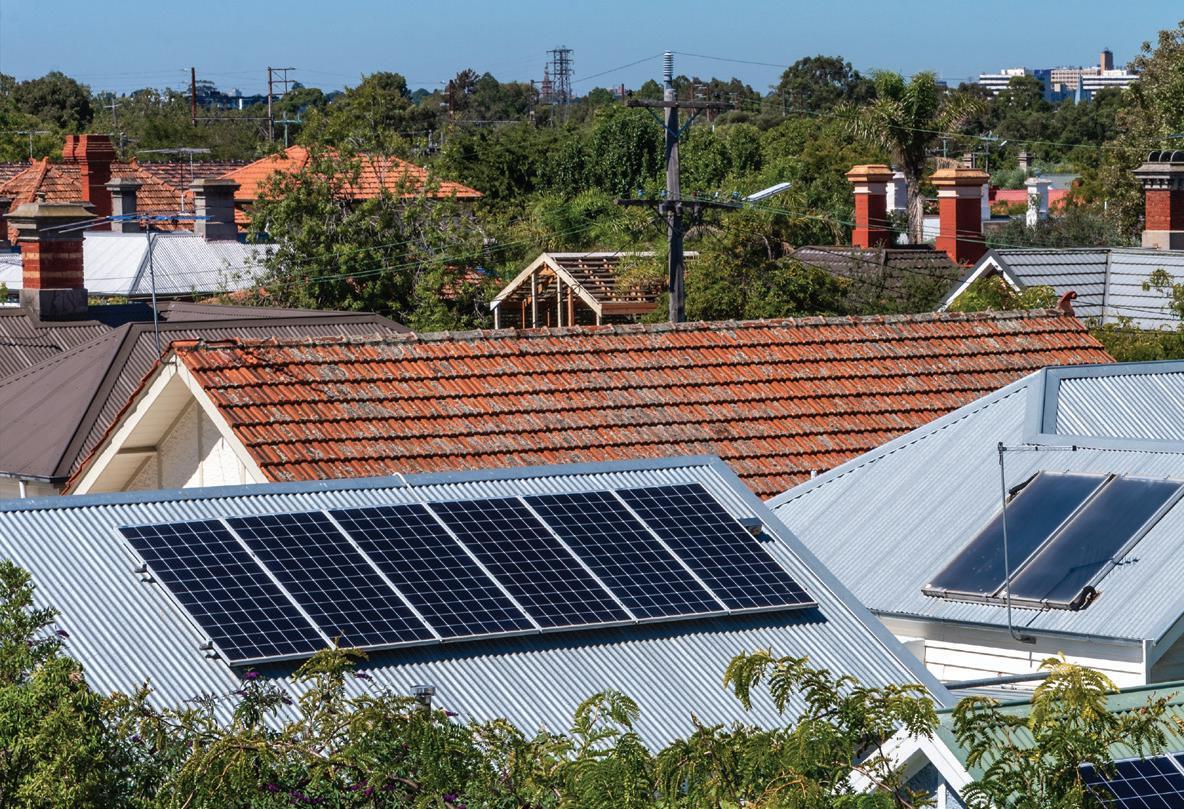
While the Australian Energy Market Commission’s recently unveiled proposal to incorporate more solar into the grid has been designed to make the system fairer for all, it has been met with concern from some commentators. Dr Bruce Mountain from the Victoria Energy Policy Centre outlines his concerns here.
It’s come to this. The Australian Energy Market Commission has produced a draft decision that will make households and small businesses with solar panels pay to inject their surplus production into the grid.
It suggests an annual charge of about $100 per solar-connected household.
The arrangement will only apply to small producers – almost all of whom are solarenabled households. It won’t apply to large producers who will continue to export to the shared grid without charge.
The Victoria Energy Policy Centre’s analysis of 7,212 household electricity bills finds the typical Victorian household with solar panels exports about 2,200 kilowatt hours per year. This is about the amount of electricity an electric vehicle needs to cover about 12,000 kilometres, which is about the average annual mileage in Australia.
On the basis of feed-in rates that will soon apply in Victoria, we estimate that the typical solar system will provide the typical Victorian household with feed-in income of around $120 per year.
The proposed export charge of $100 will therefore almost totally offset the feed-in income, meaning households with rooftop solar would effectively get nothing for the surplus power they deliver to the grid.
However, the proposed annual fee of $100 from the 2.7 million households with solar panels will raise $270m per year.
The Commission says it wants this sent back to all households in the form of lower charges. Before accounting for other factors that this change will effect, our calculations suggest this will cut the typical bill for households without solar by about 1.7 per cent. After accounting for the Commission’s sun tax, the typical bill for households with solar will increase by about seven per cent.
When the ABC and others reported the decision, it drew irate responses.
What’s the rationale?
The Commission argues that small consumers should pay to use the grid whether they are injecting electricity into it or withdrawing electricity from it, and that if charges only applied to withdrawals then
those customers that injected would be subsidised by those that withdrew.
At first sight, it seems reasonable. On closer inspection, it isn’t.
This is because the households that inject electricity also withdraw electricity and injections are typically much smaller than withdrawals and do not meaningfully increase network costs.
Residential connections are usually limited to at least 40 amps which, at 250 volts, allows a flow at the rate of ten kilowatts. Only a tiny number of rooftop solar systems produce this much – the median system is less than half that size.
This means networks can easily accommodate residential injections without incurring significant expenditure apart from a few adjustments such as balancing the voltage across phases of a circuit or adjusting transformers.
This is seldom more than routine work and it shows up as small claims approved by the regulator as “distributed energy integration”.
For Powercor, the Victorian distributor that has the highest rooftop solar penetration,
June 2021 ISSUE 14 www.energymagazine.com.au 48 STORAGE AND SOLAR
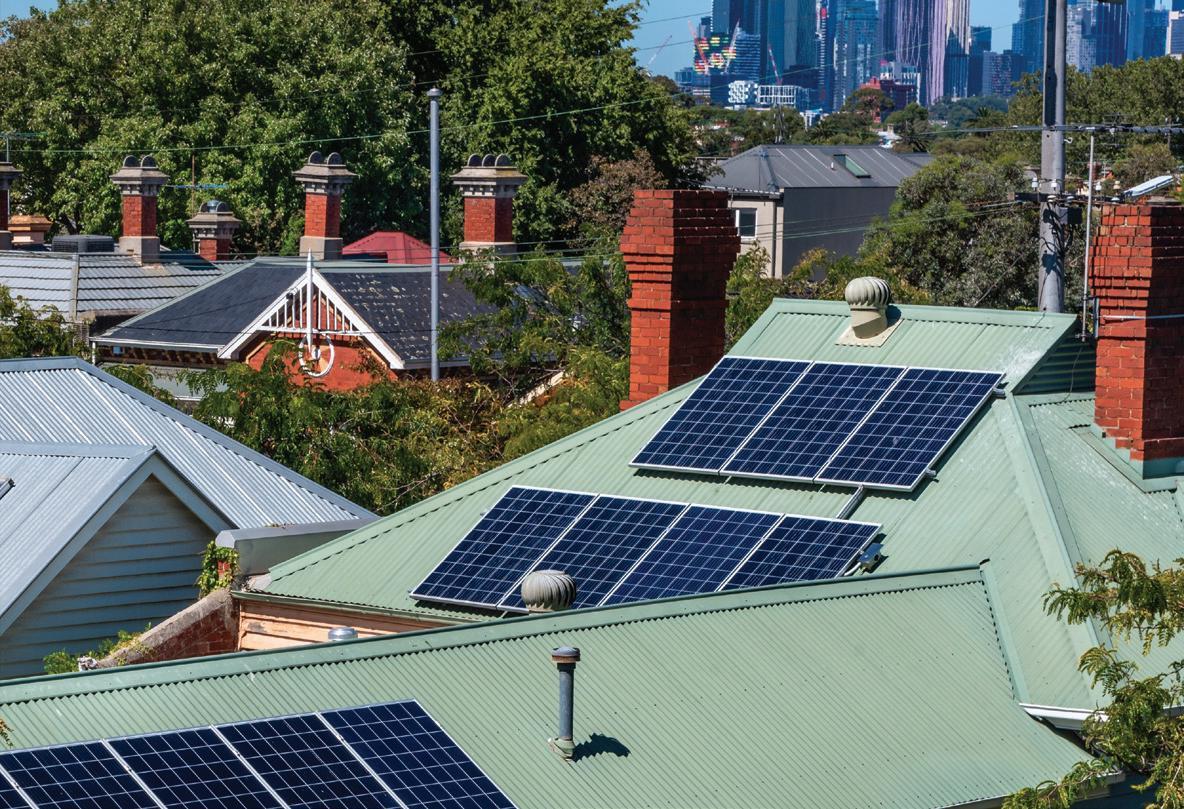
the regulator and Powercor have agreed on distributed energy integration expenditure for the next five years that will add just 0.1 per cent to its allowed revenues.
The proposed injection charge seems to reflect the Commission’s view that injectors should pay for sunk as well as incurred costs. Standard welfare economics treats sunk costs like it treats taxes. It says the best way to recover them is to raise them from the activities that the tax will change the least.
Households have little choice but to withdraw electricity from the grid (when the sun’s not shining or their battery is running low – if they have one), but they can easily choose not to install solar.
Since the Commission’s proposal will reduce typical injection income to almost zero, it is very likely to slow the uptake of solar.
This will destroy welfare. Distributed solar provides benefits for all consumers since it is close to where it is needed (and so reduces the need for transmission) and it displaces more expensive fossil fuel generation and so reduces wholesale prices.
The 2.7 million households that already have solar have another reason to be upset. It will reduce the return on the investments that governments encouraged them to make.
The Commission might feel that the consumer backlash is not its problem: it has done its job in recommending an economically sensible charge. But it is wrong: it has proposed a distortionary and welfare-destroying “sun tax”.
The states are likely to block it
The Commission reports to the states and Commonwealth. There must surely be little chance the states will accept
the recommendation. If they do, to avoid confronting an administrative behemoth, they are likely to water down the recommendation to the point where all that is left is more pointless bureaucracy.
But even this relatively benign outcome would be a mistake. It would undermine consumers’ and investors’ already fragile confidence in national energy policy.
In a previous article I argued that the states should take back control of electricity from organisations such as the Australian Energy Market Commission.
Victoria and then New South Wales passed laws last year to begin to do that and are rapidly developing their own arrangements.
The proposed sun tax is likely to encourage the states to pull away yet further.
This article originally appeared on The Conversation.
Dr Bruce Mountain is an energy economist with specialisation in regulatory economics and the design and operation of wholesale and retail electricity markets. For much of his career he has worked as an analyst and advisor to governments, regulators, customer and environmental advocates, investors and lenders in Australia and many other countries. Currently Dr Mountain is the Director of the Victoria Energy Policy Centre at Victoria University and the director of independent consultants, Carbon and Energy Markets, which is also active in the provision of retail market comparison and analytical software.
www.energymagazine.com.au June 2021 ISSUE 14 49 STORAGE AND SOLAR

TURNING LEFTOVER FOOD AND GREASE INTO POWER
June 2021 ISSUE 14 www.energymagazine.com.au 50 WASTE-TO-ENERGY
In March 2021, Victorian Minister for Energy, Environment and Climate Change, Lily D'Ambrosio, officially launched a new waste-to-energy facility for Western Water. The innovative Melton Waste to Energy Facility reduces Western Water’s greenhouse gas emissions while extracting the full value from local food waste, potentially decreasing the amount of food waste going to landfill and associated transportation costs.
The facility will treat up to 5,000 kilolitres of liquid food waste each year – including leftover cooked meals, food scraps, fats, oils, old drinks and greases – from local businesses and convert it into biogas, producing enough renewable energy to power the Western Water Recycled Water Plant (RWP).
With organic waste representing over 30 per cent of the total solid waste sent to Victoria’s landfills, this waste-to-energy facility is an important part of the Victorian Government’s targets to reduce the amount of organic waste that ends up in landfill.
The facility will generate up to 1,000MW hours of renewable electricity, reducing greenhouse gas emissions by 900 tonnes annually – the equivalent of taking 300 cars off the road each year.
The biogas produced at the facility will be used to power the RWP on site, reducing reliance on the grid and cutting Western Water’s energy costs. This is in line with the greenhouse gas emissions reduction targets in the Victorian Government’s Water for Victoria plan.
The Melton Waste to Energy Facility will contribute to the government’s goal of halving the amount of organic material going to the state’s landfills by 2030 and assist Victoria in meeting its zero net carbon target by 2050.
The Waste to Energy Infrastructure Fund is part of the government’s $380 million Recycling Victoria package, which is expanding Victoria’s recycling system and reducing the amount of waste going to landfill.
“This facility will turn food scraps, oil and grease from local businesses into clean power – reducing the plant’s greenhouse gas emissions by 900 tonnes a year – that’s the equivalent of
300 cars off the road each year,” said Victorian Minister for Energy, Environment and Climate Change, Lily D’Ambrosio.
“Food scraps and organic waste make up almost a third of all the waste sent to landfill. This new facility makes use of that material and creates enough energy to power this recycled water plant.”
Putting organic food waste to work
Organic food waste comes from natural products and mainly consists of animal and plant waste. The best organic food waste materials identified for treatment at the plant are:
» Fats, oils and greases
» Liquified food waste
» Waste by-products from food and beverage manufacturing
Several local suppliers have been identified to provide the liquid organic waste suitable for treatment at Melton. They include large food manufacturing and hospitality businesses.
The facility will meet strict requirements set by the Environmental Protection Authority to ensure there are no negative impacts on neighbours or the environment.
Any odour generated by the additional organic waste treatment will be contained within the plant’s buffer zones.
The new digester at the Melton RWP has been designed to meet the needs of the growing population for the next 15 years. As a result, it currently has ample spare capacity for treatment of other waste streams. The facility will create a new revenue stream for Western Water, helping keep the costs of services down for all customers.

www.energymagazine.com.au June 2021 ISSUE 14
51 WASTE-TO-ENERGY
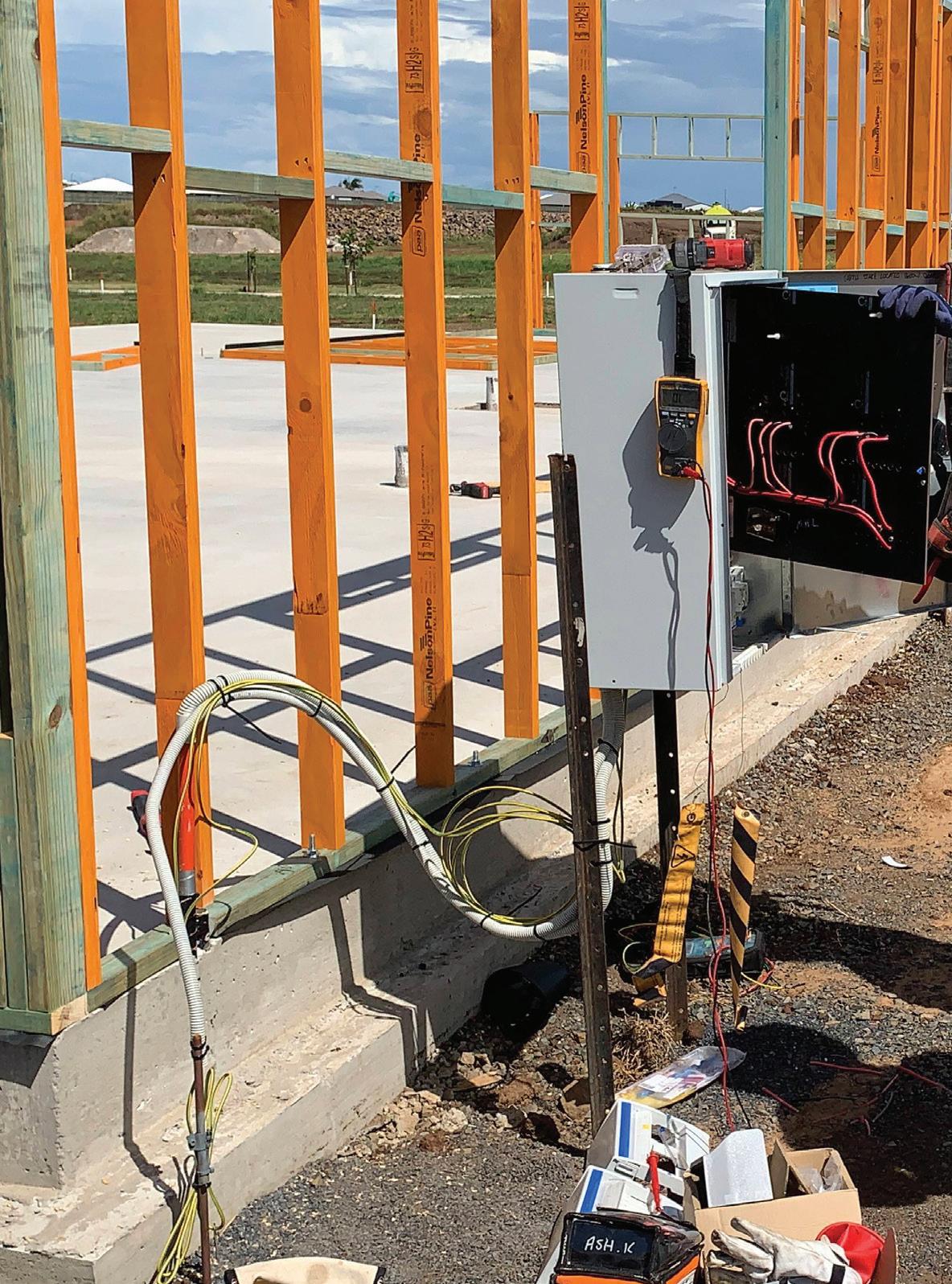
POLARITY APP SAFER WORK
June 2021 ISSUE 14 www.energymagazine.com.au 52 SAFETY AND TRAINING

MAKES FOR PRACTICES
www.energymagazine.com.au June 2021 ISSUE 14 53 SAFETY AND TRAINING
A new app developed by employees at Energex and Energy Queensland is enhancing safety out in the field for crews.
Ergon Energy Area Manager John Fry measures the value of redesigning the processes around polarity testing and development of the Polarity app in very simple terms – it helps crews get a fundamental process right.
“People can die if we get it wrong,” Mr Fry explained.
“The app is available to everyone in the field and it provides them not only with a tool to help them get the process right for polarity testing, it also provides our people with evidence they’ve followed the right procedure.”
It is now a requirement that every member of every crew across the Ergon and Energex networks have the Polarity app on their phones and use it when performing testing.
The business is now doing more than 60,000 tests each year since the first trial of the Polarity app in September 2019 and significant incident frequency rate has decreased because of the new processes guided by the app.
“The first step was to revise the test process to align to how work is actually completed, increasing the knowledge of staff performing the testing and ensuring the polarity testing is carried out correctly by stepping them through the required steps,” Mr Fry said.
“The old processes weren’t easy to follow and people who thought they knew the process were missing steps, so we really needed a tool that could tidy that up and give people a sequence to follow based on the activity they were doing.”
From start to finish the development, testing and implementation of the Polarity app, which was the concept of field person Mick Bellero, took about four months.
With the assistance of John Crighton, Training and Support Officer (Customer Connections) at Energex and Ashley Coote, Process and Technology Improvements Manager at Energy Queensland, hundreds of field staff across the state also helped design, test and improve the app.
“Initially everyone thought we needed to make the process shorter and simpler because we were bringing it together for both Ergon Energy and Energex crews, but the reality was that as we started pulling the process apart, we realised we had to add a few steps to control the hazards that were catching us out,” Mr Fry said.
“We deferred to expertise at all stages – we had field crews who do polarity tests all the time, so we leaned on them for the detail of what they thought worked and what didn’t’.”
Mr Fry said it was the same with the technical side of developing an app to support the process.
That’s where Mr Coote’s expertise was sought.
Mr Coote describes the development experience in somewhat paradoxical terms – taking a super complex process, adding more complexity to it so that a simple solution could be devised in the form of a tool that crews wanted and would use.
“This wasn’t a case of the business rolling out a tool and telling crews to use it – the people in the field were driving this which meant it was always going to be easier to implement, if we could get the interface and the interactions right,” Mr Coote explained.
“I remember one of the first interactions where I was talking to one of the team who came up with the idea for the app and he described himself as being okay on a computer.
“They said they would cut and paste the processes together as a starting point and that’s literally what they did with sections of printed pages being cut and then pasted onto another page –that’s not having a shot at them – but it gives you an idea of where we had to start.

“It really showed the diversity and different ways people think and work.”
Over the next few months Mr Coote knocked up a rough prototype and let it loose on the crews.
While Polarity app V1 was better than anything the crews previously had access to, Mr Fry knew that it could be much better.
“Even after we launched the first version of the app for trial in the field, I knew we’d have to tinker with it, and we did,” Mr Fry said.
“That was why we put it out into the field – to defer to expertise so we could gather information and experiences from a really broad range of crews, because they were the ones who needed to use it.”
While that first version was in the field, Mr Coote was already re-designing an update to deploy.
“I reckon about 300 people touched the app at some time during its development, in the learning groups and testing groups and in field trials.”
Those 300 “testers” became more than 2,000 when the Polarity app V1 went live with greater functionality, better accessibility and a clear process for crews all in one package.
“It was a big win,” Mr Coote said.
June 2021 ISSUE 14 www.energymagazine.com.au
54 SAFETY AND TRAINING
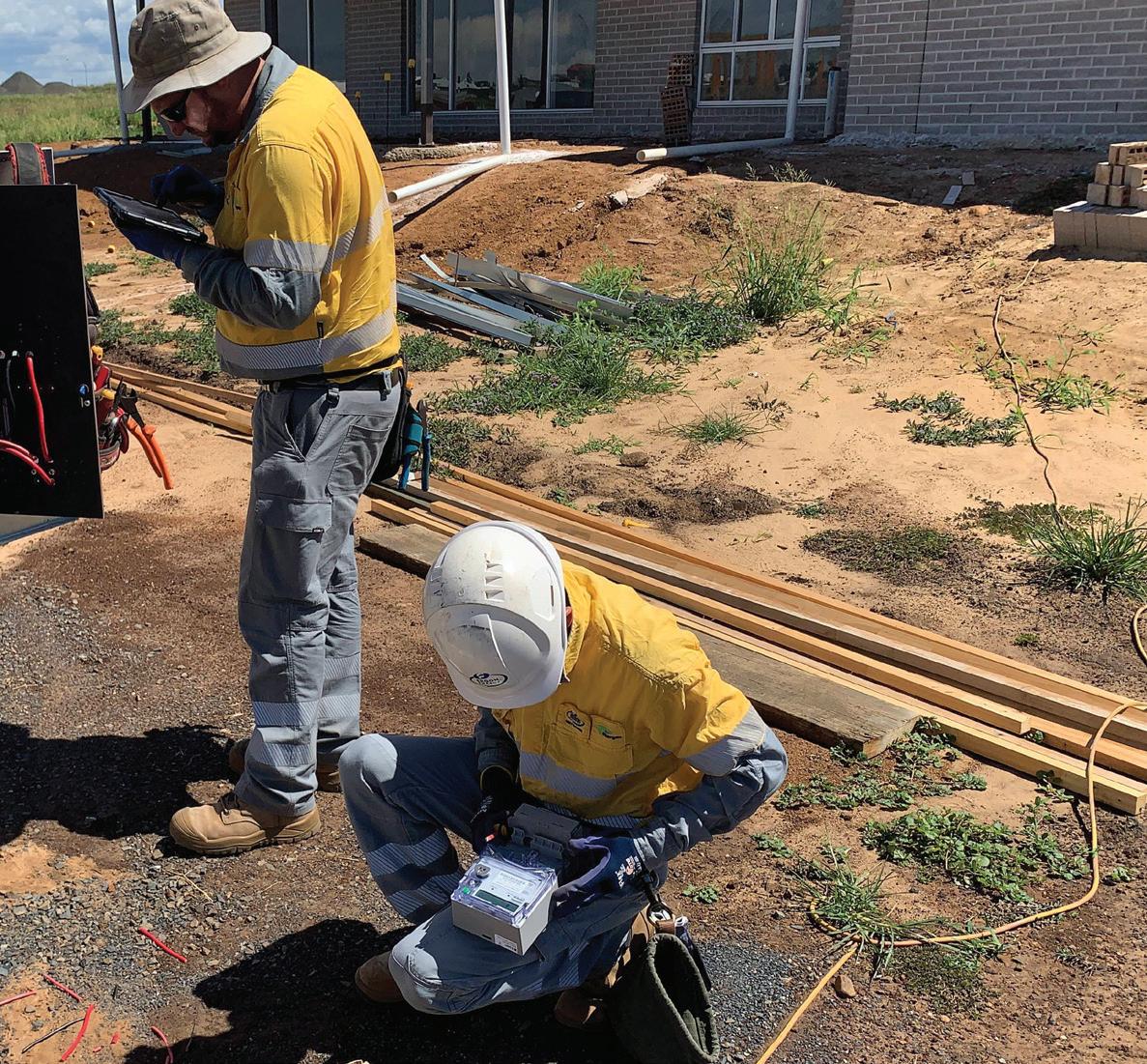
“There were some technical challenges – like how we managed data capture when our crews were out of mobile service range. You’ve got to remember just how remote some of our customers are and how far crews have to travel to get to them. But we managed to work around them and deliver an updated tool that was fit for purpose and delivered just about everything the crews wanted from functionality.”
The ability to capture step by step images for each job offers multiple levels of protection for users and the business.
Bundaberg Electrical Mechanic Ashley Klinstrom describes the Polarity app as an “excellent bit of kit”.
“It’s a process that’s written – there’s no need to rely on what you think might be the way to do it – you follow it from start to finish and there’s no missing any parts,” Mr Klinstrom said.
“The functionality to be able to recall pictures to either remind you of the job or to jump into a job that someone else has started is excellent – you’re not going into a job blind, it’s all there for you so you don’t mess things up or leave things out.”
The next iteration of the Polarity app will be a shift from the PowerApp platform to an iOS native version.
Mobile Applications Platform Manager Dan Massey said not much should change – it will just be a more robust solution.
“We want to replicate what we’ve got in the current PowerApp as much as possible to reduce the end user impact,” Mr Massey said.
“The update we’re working on is about improving the reliability and tweaking some of the functionality so there is a flow on from how the app works to how the crews use it.”
Some of that functionality is likely to provide the foundation for some hands-free capability which in turn will provide extra safety and efficiencies.
“If we can get that right it means less stop-start time on jobs because crews will be able to work with the app without having to take their gloves off,” Mr Massey said.
“It will improve safety because it will also reduce the number of times they have to look away from a job.
“They seem like little tweaks but we want to enhance the app so it’s a better tool that’s helping our crews do the job properly and keeping them safe.”
www.energymagazine.com.au June 2021 ISSUE 14 55 SAFETY AND TRAINING
Employees using the Polarity app in the field.
UNVEILING THE HIDDEN RISKS IN POWER SYSTEM EARTHING
Some risks are hard to ignore. The sound of a spinning turbine or snapping air breaker grabs your attention – it’s obvious that a failure could be catastrophic, and risk evaluation and mitigation follows somewhat instinctively. Earthing systems however, passive and innocuous, are often buried beneath the surface and hardly seem threatening. When earthing systems ‘operate’, they are unremarkable and are typically unnoticed. But when they fail to operate correctly, the results can be devastating.
What are the risks?
Power system earthing exists to provide three main functions: (1) keep people safe, including staff and the public; (2) protect equipment against damage, which can be costly, but secondary consequences can also be of significance to people; and (3) maintain system operations, which relies on adequate earthing to perform normal functions, particularly during adverse events.
The most prominent risk to safety is the exposure to voltages that would cause harm – most notably, current flowing through the heart leading to ventricular fibrillation.
But how does poor earthing lead to dangerous voltages? Isn’t earth safe by definition? When current flows through the earth and earthing systems (which occurs during both normal and fault conditions) voltages are produced on earthed components. If the earthing system is appropriately designed and operating effectively, these voltages should be sufficiently low to present negligible
risk. However, changes in the condition of the earthing, such as deterioration or inadvertent modifications, can result in increases in voltage and/or exposure, and unacceptable risk. And faults or changes in the earthing system can sit undetected – the first noticeable sign might be an electric shock!
There are a range of criteria and approaches to help determine whether faults and changes are appropriately detected and that the risk is appropriately managed. To read on this further, refer to Australian Standard AS2067:2016, or for a more detailed explanation, the ENA Earthing Guide EG-0 or the CIGRE Technical Brochure TB-749.
Effective earthing is often also critical to protect equipment from excessive voltage or current. Equipment failure can significantly interrupt network function, but can also be explosive or lead to the transfer of voltage hazards.
When earthing systems fail to work appropriately, other parts of the system can also fail to operate correctly. For example, if earthing is ineffective, a circuit breaker may not detect or properly clear a short circuit on a cable or powerline. Such failures, or maloperations, can create significant disruption, cost and safety risk, but can also be difficult to find root causes for, particularly where the cause is related to earthing systems or lightning protection systems.
Both good design and good testing are required
A well-designed system manages all of these risks, to a level legally and socially required, or to a lower risk if required by the asset owner or operator. But good design is only a first step toward acceptable risk. Testing to verify the installation and validate the design, and then testing to detect change has become increasingly common and has more recently become clearly required of asset owners and operators (see AS2067 §9, §8.6; Appendix H also gives guidance on inspection and testing methods commonly used).

With all risks, but particularly those where latent or undetected faults may exist, the absence of evidence is not the same as the evidence of absence. If you want to be confident that your earthing systems represent an appropriate and acceptable risk, then you need to collect the evidence.
Condition (or state) assessments include visual inspection and continuity testing – demonstrating the effective bonding (or appropriate separation) of items to the earthing system. Continuity testing does not directly measure condition, but provides patterns of resistances from one reference point, which can aid the tester in the identification of issues such as broken (or stolen!) bonds, deteriorated
56 SAFETY AND TRAINING SPONSORED EDITORIAL
buried conductors, or loose connections. This testing can be carried out on live assets, without the need for power disruption. Results can also be trended over time, giving a supplemental indicator of condition.
The principal test for performance is the low-current, off-frequency injection test, pioneered by Safearth, which simulates a single line to ground fault, often using the powerline or cable itself, and measures the resulting hazards and other impacts. Once the test circuit and source current are established, a tunable voltmeter can directly measure touch voltages, step voltages and other transfer voltages, as well as voltages impressed on other systems such as pipelines or telecommunications systems. This test method provides hazard and risk determinations with much lower error than could be achieved using numerical software modelling tools.
The distribution of the test current can also be measured, using an open-ended

Testing in 1994 with Australia’s first commercial earthing test equipment for low current, off-frequency injection testing, produced under licence using Safearth’s designs.


current transformer called a Rogowski coil. It can be wrapped around a pipe, shield wire, low voltage neutral or any other conductor to directly measure the proportion of test current flowing through each of the available paths. Measurement with an appropriate instrument allows for vector current measurement, including both magnitude and phase, providing much greater accuracy.
This testing utilises specialised instruments that can allow measurement of the test signals without being swamped by the electrical noise of an operating power system. This enables testing to be carried out on and around in-service assets.
Testing and analysis can often be quite technical, but it is difficult to manage these systems without a detailed technical understanding. Safearth, as Australia’s leading earthing and lightning protection specialists and pioneers in testing methodology and equipment, are wellequipped to provide training and assistance.

Incorrect earthing led to protection being unable to operate when a cable shorted to ground at Cudal Quarry, resulting in a fatal electric shock.
We’re very proud to have achieved so much in the last 30 years. Earthing has come a long way!
With more than 25 degree-qualified professional engineers, Safearth is the largest and most experienced team of earthing engineers in Australia.
We’ve worked with clients around the country to save them thousands of dollars in project implementation and ongoing maintenance costs whilst improving their safety.

Our offices
○ Where we’ve worked
safearth.com
enquiries@safearth.com
1800
844
SPONSORED EDITORIAL SAFETY AND TRAINING
327
THE SAFEST
WAY TO MEASURE VOLTAGE
The first goal of any electrician or technician who works around live voltage is to go home safe. Traditionally voltage has been measured by attaching test lead probes or alligator clips directly to electrical conductors. This requires metal-to-metal contact that brings with it the risk of arc flash and potential harm to both the person doing the measuring and the equipment being measured.
Fluke FieldSense™ technology offers a safer way to measure voltage by isolating the measurement tool from the voltage source under test. This reduces the risk of electrical shock and arc flash. Through the principle of galvanic isolation, FieldSense™ allows electricians and technicians to measure voltage without exposing themselves to contact points with live voltage. Instead, FieldSense™-enabled test tools such as the Fluke T6 series of Electrical Testers and the new Fluke FieldSense™ 377 FC and 378 FC Clamp Meters sense the electrical field in the open fork/clamp and measures the voltage through the cable insulation.
Commercial and light industrial electricians can use FieldSense™-based devices for voltage and current measurements, verifying continuity values, and testing individual circuits.
Here are the top four ways this non-contact voltage measurement technology can help you work safer:
Measuring voltage can be a tricky situation to navigate, and it can be hard to ensure operator safety. But now, a new technology has emerged which is making it easier to measure voltage in the safest possible way.

To learn more about how FieldSense™ can work for you and your crews, head to fluke.co/FieldSense-AU
1. No metal-to-metal contact when measuring ac voltage
In the past, measuring voltage has required metal-to-metal connection via probes or alligator clips to the conductor, which immediately put crews at risk of spark or arc flash. Fluke FieldSense™ technology allows you to measure ac voltage, current, and frequency through the cable’s insulation by sliding the fork/clamp of the tester over the conductor. There is no direct electrical contact with live voltage so there’s much less potential for electrical shock or arc flash. You can work safer and faster.
2. Goes beyond detection to let you know how much voltage is present
In the past, the non-contact voltage could only be detected with light and sound indication, but contact was still required to actually measure the voltage. FieldSense™ devices go way beyond those to show you not only that live voltage is present, but also provide you with voltage readings. FieldSense™ technology injects a known signal to accurately derive the unknown ac voltage. This produces an actual ac voltage measurement, unlike traditional non-contact voltage detectors that only detect if voltage is present. Operators can now have voltage detection and measurement in one step, with one tool.
3. Reduces the need to open panels because you can access wires at junction boxes
FieldSense™-enabled devices don’t need access to wire end points, so you can take a measurement at any point along the conductor. This makes it much easier to quickly measure ac voltage and current on traditionally inaccessible measurement points such as crowded junction boxes. All you need to do is slide a single conducting wire into the open fork/clamp, read the results, and you’re done in no time.
4. One-handed voltage measurements
As FieldSense™ technology eliminates the need to fuss with test leads, in many cases you can accurately measure voltage with one hand. The open fork/clamp form factor makes it easier to isolate individual hot and neutral wires, which in turn helps reduce the chance of accidental contact with another voltage point and the likelihood of errors. You’ll save time – and perhaps a lot more.
June 2021 ISSUE 14 www.energymagazine.com.au
58 SAFETY AND TRAINING SPONSORED EDITORIAL
MAKING A DIFFERENCE IN THE ENERGY TRANSITION
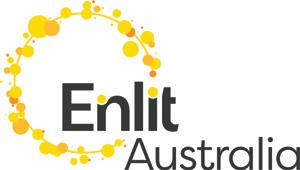
Enlit Australia is the opportunity we have all been waiting for to get together as an industry, network and reconnect over the latest trends, disruptions, and market opportunities.
The conference and exhibition vows to light the spark that will fuel the change we need to ensure our industry – and our planet – have the brightest possible future.
We believe in an equitable energy transition that leaves no one behind. From corporates to consumers, investors to entrepreneurs, and engineers to activists – Enlit exists to give everyone the ability to seize all of the opportunities that the energy transition has to offer.
Enlit Australia is taking place July 21–22 at the Melbourne Convention and Exhibition Centre, bringing together the biggest names in Australia’s energy industry.
Energy is evolving. So are we – so are you. Together we will make a difference.
Anyone interested in attending can register now for a free expo pass, which will allow attendees to hear from more than 80 leading industry speakers, including:
» David Hochschild, Chair of the California Energy Commission (USA)
» Karl Rábago, Principal of Rábago Energy (USA)
» Lily D’Ambrosio, Victorian Minister for Energy, Environment and Climate Change, and Minister for Solar Homes
» Maia Schweizer, Chief Executive Officer, CleanCo Queensland
» Andrew Bills, Chief Executive Officer, CS Energy
» Anna Collyer, Chair, Australian Energy Market Commission
» Richard Lowe, Executive General Manager Business Growth, TransGrid
» Ramesh Singaram, President and CEO, GE Gas Power Asia Pacific
» Joao Segorbe, Executive General Manager Strategy & Corporate Development, AGL Energy
» Jon Briskin, Executive General Manager, Origin Retail
» Gordon Wymer, Chief Commercial Officer, Snowy Hydro
Energy Editor Laura Harvey will be at Enlit Australia, hosting the Chief Executive session taking place in the morning of July 21 – we look forward to seeing you there!

www.energymagazine.com.au June 2021 ISSUE 14 59 EVENTS

LIGHTING THE WAY
FOR A RESPONSIBLE AND RESPECTFUL ENERGY TRANSITION
June 2021 ISSUE 14 www.energymagazine.com.au 60 ASSET MANAGEMENT
The retiring Yallourn power station.
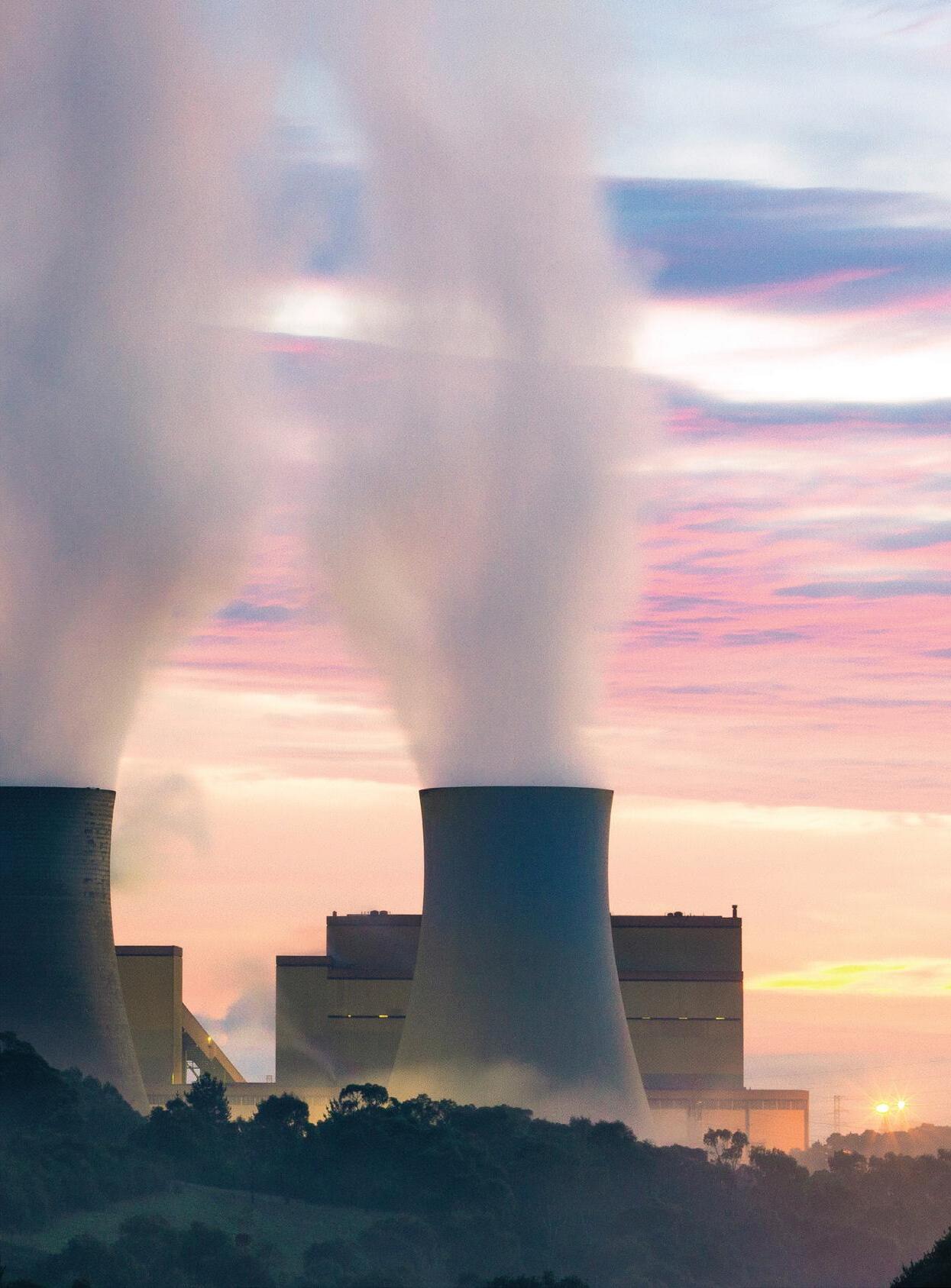
www.energymagazine.com.au June 2021 ISSUE 14 61 ASSET MANAGEMENT

EnergyAustralia recently announced that after decades of faithful service, Yallourn Power Station in Victoria’s Latrobe Valley would be retiring in mid-2028 instead of the previously planned 2032.
Energy Executive Liz Westcott said she hopes that the cloud of uncertainty surrounding Yallourn’s retirement date has been removed, and in its place, the energy market, local community and Yallourn workforce have been provided muchneeded clarity.
“The transition to a clean energy future in Australia matters. We believe the best way for it to succeed is with a good plan that balances a lot of things. Simply, what we are trying to achieve is too important to leave to chance.
workers to have a say in how this support is delivered and will now begin a process to understand individual needs.”
Liz said that in the lead up to Yallourn’s retirement seven years from now, EnergyAustralia will be ensuring the approach delivers on the high standards expected by the local community.
“It’s always our goal to be a good neighbour for those living near where our assets are based. At Yallourn, we will be present and available to the local community. We’ve held forums and plan on smaller face-to-face sessions so that different interest groups and locals are clear on our plans.
In March, EnergyAustralia announced it was bringing forward the closure of the Yallourn Power Station by four years. In mapping out the transition, they are determined to achieve the best possible outcomes for the community, its employees and the energy market as a whole.
“By supporting people, the Latrobe Valley, and locking in new energy storage, we hope to give the communities we serve confidence in the smoothest transition possible,” Liz said.
EnergyAustralia has committed to a multimillion-dollar support package for Yallourn Power Station and mine workers to help them plan, reskill or retrain.
“Yallourn’s retirement will mean different things to different people. It’s our job to ensure the approach is a respectful and collaborative one to meet individual needs. With a clear timeframe to work to, we can support our people and help them prepare for the next stage in their careers,” Liz said.
“Our support package will include training and skills development, career planning, assistance for redeployment, and financial counselling. We want Yallourn
“Arguably most important, we will also be working with the surrounding local communities and other stakeholders to better understand and manage potential closure impacts.
“Our commitment to the social development of the Latrobe Valley region remains the same, including our community grant and sponsorship programs. Our power station maintenance programs also continue, which draw in local suppliers and additional workers each year.”
A changing of the guard
Liz said that through these efforts, big and small, EnergyAustralia is determined to demonstrate that coal-fired power can exit the market in a way that supports people and ensures customers continue to receive reliable energy.
“With Yallourn coming out of the system, it’s only right something must enter to maintain system security and reliability.

62 ASSET MANAGEMENT
Liz Westcott.
“EnergyAustralia has committed to building a utility-scale battery storage facility that will provide an economic boost for the Gippsland region. Complemented by other technologies, the project will help to secure Victoria’s energy supply and enable more renewables to enter the system,” she said.
Co-located with EnergyAustralia’s Jeeralang gas-fired power station in the Latrobe Valley, the new battery facility will be 350 megawatts and provide energy for up to four hours at a time.
The Jeeralang battery is scheduled to be commissioned before the end of 2026, well in advance of the Yallourn Power Station’s closure. It will be larger than any battery operating in the world today.
Liz said the advantages of batteries in the formation of a modern energy system are immense.
“Batteries store electricity at times when lots of renewable energy is being produced. They’re also fast response – the quick release of stored energy during periods of high demand helps maintain supply and keep costs down for customers.”
Liz said that by providing ample notice ahead of Yallourn’s retirement date in mid-2028, and introducing new battery storage, EnergyAustralia is making good on its ambition to be carbon neutral by 2050.
“In closing Yallourn, we will reduce our carbon dioxide emissions by more than 60 per cent, relative to today. To put that in context, Yallourn’s closure will remove around 13 million tonnes of carbon dioxide Scope 1 emissions per year.”

Liz said that EnergyAustralia will be harnessing the company’s history, and the expertise of its workforce, to repower Victoria.
“For more than a century Victoria’s Latrobe Valley has generated electricity to illuminate, warm, cool and power millions of homes and businesses across the state and the country.
“The energy system is changing and it’s our responsibility to lead the transition to cleaner energy in a way that does not leave the workforce or the community behind. At the same time, we want to maintain the same reliable and affordable access to energy for everyone.
“The challenge to getting this right has always been planning; getting the right balance and mix for a modern energy system – in the most cost-effective manner.
“By committing to the Jeeralang battery, we are delivering clarity with yet another important puzzle piece. And with seven years’ notice in advance of Yallourn’s retirement, the market is also given a clearer picture so they too can make the commitments required.

“Success years from now sees each home and businesses in Australia having access to energy that is reliable, affordable, and above all, clean. At EnergyAustralia we will continue playing our important role,” Liz said.
63 ASSET MANAGEMENT
The Jeeralang battery will be charged with renewable energy during the day for the community to use when the sun isn’t shining or the wind isn’t blowing.
64 June 2021 ISSUE 14 www.energymagazine.com.au MAJOR FEATURES Grid integration and stabilisation Disruption Embedded networks Biofuels SPECIAL FOCUS Electric vehicles IoT & cloud communication Demand management EQUIPMENT & MACHINERY Switchgear November 2021 Deadline: 15 October 2021 FEATURES SCHEDULE
AGC Plastics 5 Altra Industrial Motion 33 Antai Solar Australia 43 Australian Private Networks ................................................................................................................................................ 29 Energy Networks 2021 ........................................................................................................................................................IBC Fluke Australia ................................................................................................................................................................... IFC Logsys Power Services ........................................................................................................................................................... 7 Monkey Media .................................................................................................................................................................... 21 Pacific Green Technologies ............................................................................................................................................... OBC R&J Batteries ........................................................................................................................................................................ 9 ResourceCo ......................................................................................................................................................................... 23 Safearth .............................................................................................................................................................................. 57 ADVERTISERS’ INDEX MAJOR FEATURES Energy networks Storage and solar Safety and risk management Waste-to-energy SPECIAL FOCUS Automation Asset management Industrial energy EQUIPMENT & MACHINERY Transformers and substations Vegetation management MAJOR FEATURES Solar Domestic gas outlook Hydrogen and future fuels SPECIAL FOCUS Smart networks Consumer and industrial retail Security EQUIPMENT & MACHINERY Spatial & GIS MAJOR FEATURES Wind Nuclear energy Gas pipelines Energy efficiency SPECIAL FOCUS Microgrids Disaster management Distributed generation EQUIPMENT & MACHINERY Asset inspection & drones/UAVs September 2021 Deadline: 23 July 2021 June 2022 Deadline: 29 April 2022 March 2022 Deadline: 4 February 2022
FEATURES SCHEDULE
Brisbane Convention & Exhibition Centre
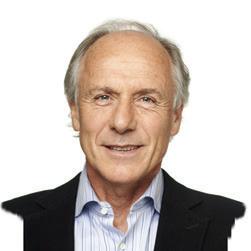


Dr Alan Finkel AO
Special Adviser to the Australian Government on Low Emissions Technology
Chair of the Australian Government’s Technology Investment Advisory Council
Dermot Nolan Former CEO, OFGEM UK
Distinguished Professor Genevieve Bell AO
Director, School of Cybernetics, ANU
www.EN2021.com.au
KEYNOTE SPEAKERS
RESEARCH PARTNER PRINCIPAL SPONSOR
Leading Energy Storage
For when you need proven battery technology with guaranteed performance
The Pacific Green Approach
Pacific Green Energy Storage Technologies delivers industry leading expertise gained from the deployment of hundreds of megawatts of capacity globally.
Wherever you are in the world, we can provide a full review and consultancy service to assess your requirements, deliver a full implementation and commissioning service, and make sure you benefit from fully automated, trouble-free operation with one of the most advanced battery systems on the market.
info@pacificgreen.tv
www.pacificgreen-energystorage.com

Evaluating your energy storage battery return on investment.
We’ll help you identify applications that can drive value and deliver a quicker payback on your capital outlay.
Delivering fast, effective installation and commissioning.
Once you’ve chosen the right system for your business, we’ll install the battery, enclosure and control software on a turnkey basis.
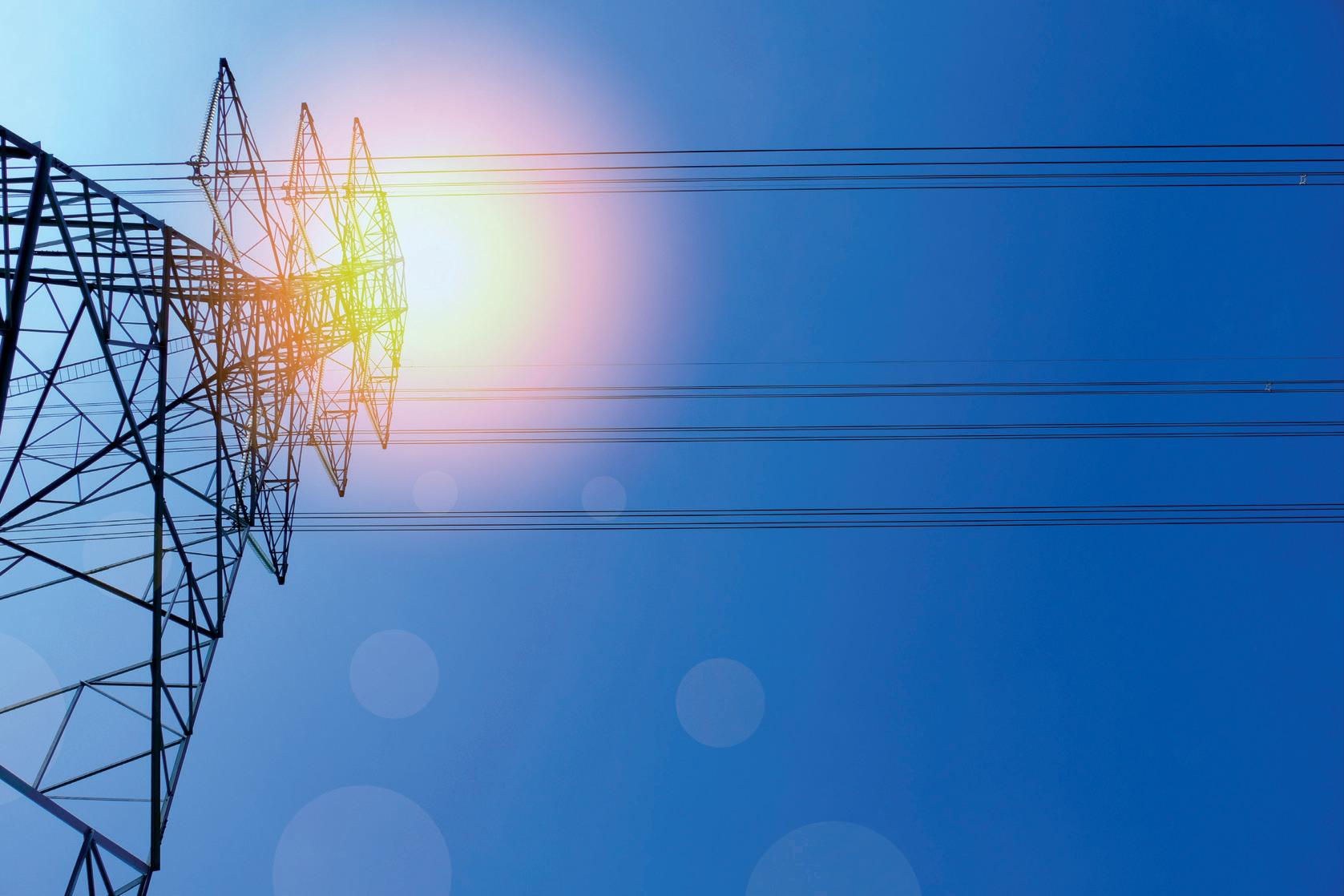
Guaranteeing trouble-free operation.
We offer the latest in energy storage battery technology coupled with a range of system-level guarantees, giving you absolute peace of mind.
Part of the Pacific Green Technologies Group
Grid Scale / Co-Located / Commercial & Industrial + + +









































 by Dr Larry Marshall, Chief Executive, CSIRO
by Dr Larry Marshall, Chief Executive, CSIRO





























































































































